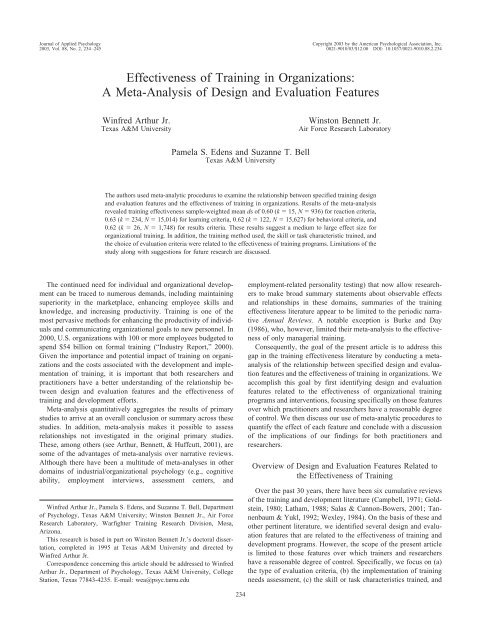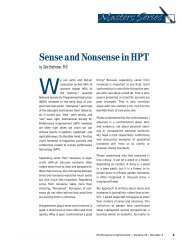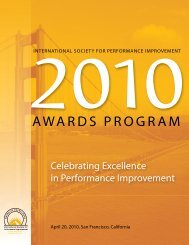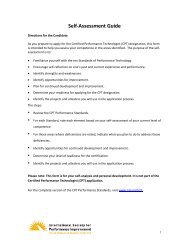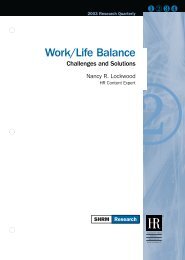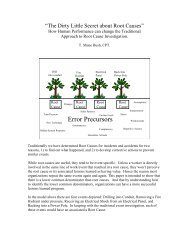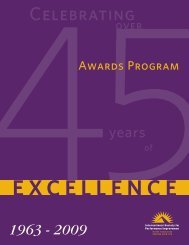Effectiveness of Training in Organizations: A Meta-Analysis of ...
Effectiveness of Training in Organizations: A Meta-Analysis of ...
Effectiveness of Training in Organizations: A Meta-Analysis of ...
Create successful ePaper yourself
Turn your PDF publications into a flip-book with our unique Google optimized e-Paper software.
Journal <strong>of</strong> Applied Psychology<br />
Copyright 2003 by the American Psychological Association, Inc.<br />
2003, Vol. 88, No. 2, 234–245 0021-9010/03/$12.00 DOI: 10.1037/0021-9010.88.2.234<br />
<strong>Effectiveness</strong> <strong>of</strong> <strong>Tra<strong>in</strong><strong>in</strong>g</strong> <strong>in</strong> <strong>Organizations</strong>:<br />
A <strong>Meta</strong>-<strong>Analysis</strong> <strong>of</strong> Design and Evaluation Features<br />
W<strong>in</strong>fred Arthur Jr.<br />
Texas A&M University<br />
W<strong>in</strong>ston Bennett Jr.<br />
Air Force Research Laboratory<br />
Pamela S. Edens and Suzanne T. Bell<br />
Texas A&M University<br />
The authors used meta-analytic procedures to exam<strong>in</strong>e the relationship between specified tra<strong>in</strong><strong>in</strong>g design<br />
and evaluation features and the effectiveness <strong>of</strong> tra<strong>in</strong><strong>in</strong>g <strong>in</strong> organizations. Results <strong>of</strong> the meta-analysis<br />
revealed tra<strong>in</strong><strong>in</strong>g effectiveness sample-weighted mean ds <strong>of</strong> 0.60 (k 15, N 936) for reaction criteria,<br />
0.63 (k 234, N 15,014) for learn<strong>in</strong>g criteria, 0.62 (k 122, N 15,627) for behavioral criteria, and<br />
0.62 (k 26, N 1,748) for results criteria. These results suggest a medium to large effect size for<br />
organizational tra<strong>in</strong><strong>in</strong>g. In addition, the tra<strong>in</strong><strong>in</strong>g method used, the skill or task characteristic tra<strong>in</strong>ed, and<br />
the choice <strong>of</strong> evaluation criteria were related to the effectiveness <strong>of</strong> tra<strong>in</strong><strong>in</strong>g programs. Limitations <strong>of</strong> the<br />
study along with suggestions for future research are discussed.<br />
The cont<strong>in</strong>ued need for <strong>in</strong>dividual and organizational development<br />
can be traced to numerous demands, <strong>in</strong>clud<strong>in</strong>g ma<strong>in</strong>ta<strong>in</strong><strong>in</strong>g<br />
superiority <strong>in</strong> the marketplace, enhanc<strong>in</strong>g employee skills and<br />
knowledge, and <strong>in</strong>creas<strong>in</strong>g productivity. <strong>Tra<strong>in</strong><strong>in</strong>g</strong> is one <strong>of</strong> the<br />
most pervasive methods for enhanc<strong>in</strong>g the productivity <strong>of</strong> <strong>in</strong>dividuals<br />
and communicat<strong>in</strong>g organizational goals to new personnel. In<br />
2000, U.S. organizations with 100 or more employees budgeted to<br />
spend $54 billion on formal tra<strong>in</strong><strong>in</strong>g (“Industry Report,” 2000).<br />
Given the importance and potential impact <strong>of</strong> tra<strong>in</strong><strong>in</strong>g on organizations<br />
and the costs associated with the development and implementation<br />
<strong>of</strong> tra<strong>in</strong><strong>in</strong>g, it is important that both researchers and<br />
practitioners have a better understand<strong>in</strong>g <strong>of</strong> the relationship between<br />
design and evaluation features and the effectiveness <strong>of</strong><br />
tra<strong>in</strong><strong>in</strong>g and development efforts.<br />
<strong>Meta</strong>-analysis quantitatively aggregates the results <strong>of</strong> primary<br />
studies to arrive at an overall conclusion or summary across these<br />
studies. In addition, meta-analysis makes it possible to assess<br />
relationships not <strong>in</strong>vestigated <strong>in</strong> the orig<strong>in</strong>al primary studies.<br />
These, among others (see Arthur, Bennett, & Huffcutt, 2001), are<br />
some <strong>of</strong> the advantages <strong>of</strong> meta-analysis over narrative reviews.<br />
Although there have been a multitude <strong>of</strong> meta-analyses <strong>in</strong> other<br />
doma<strong>in</strong>s <strong>of</strong> <strong>in</strong>dustrial/organizational psychology (e.g., cognitive<br />
ability, employment <strong>in</strong>terviews, assessment centers, and<br />
W<strong>in</strong>fred Arthur Jr., Pamela S. Edens, and Suzanne T. Bell, Department<br />
<strong>of</strong> Psychology, Texas A&M University; W<strong>in</strong>ston Bennett Jr., Air Force<br />
Research Laboratory, Warfighter <strong>Tra<strong>in</strong><strong>in</strong>g</strong> Research Division, Mesa,<br />
Arizona.<br />
This research is based <strong>in</strong> part on W<strong>in</strong>ston Bennett Jr.’s doctoral dissertation,<br />
completed <strong>in</strong> 1995 at Texas A&M University and directed by<br />
W<strong>in</strong>fred Arthur Jr.<br />
Correspondence concern<strong>in</strong>g this article should be addressed to W<strong>in</strong>fred<br />
Arthur Jr., Department <strong>of</strong> Psychology, Texas A&M University, College<br />
Station, Texas 77843-4235. E-mail: wea@psyc.tamu.edu<br />
employment-related personality test<strong>in</strong>g) that now allow researchers<br />
to make broad summary statements about observable effects<br />
and relationships <strong>in</strong> these doma<strong>in</strong>s, summaries <strong>of</strong> the tra<strong>in</strong><strong>in</strong>g<br />
effectiveness literature appear to be limited to the periodic narrative<br />
Annual Reviews. A notable exception is Burke and Day<br />
(1986), who, however, limited their meta-analysis to the effectiveness<br />
<strong>of</strong> only managerial tra<strong>in</strong><strong>in</strong>g.<br />
Consequently, the goal <strong>of</strong> the present article is to address this<br />
gap <strong>in</strong> the tra<strong>in</strong><strong>in</strong>g effectiveness literature by conduct<strong>in</strong>g a metaanalysis<br />
<strong>of</strong> the relationship between specified design and evaluation<br />
features and the effectiveness <strong>of</strong> tra<strong>in</strong><strong>in</strong>g <strong>in</strong> organizations. We<br />
accomplish this goal by first identify<strong>in</strong>g design and evaluation<br />
features related to the effectiveness <strong>of</strong> organizational tra<strong>in</strong><strong>in</strong>g<br />
programs and <strong>in</strong>terventions, focus<strong>in</strong>g specifically on those features<br />
over which practitioners and researchers have a reasonable degree<br />
<strong>of</strong> control. We then discuss our use <strong>of</strong> meta-analytic procedures to<br />
quantify the effect <strong>of</strong> each feature and conclude with a discussion<br />
<strong>of</strong> the implications <strong>of</strong> our f<strong>in</strong>d<strong>in</strong>gs for both practitioners and<br />
researchers.<br />
Overview <strong>of</strong> Design and Evaluation Features Related to<br />
the <strong>Effectiveness</strong> <strong>of</strong> <strong>Tra<strong>in</strong><strong>in</strong>g</strong><br />
Over the past 30 years, there have been six cumulative reviews<br />
<strong>of</strong> the tra<strong>in</strong><strong>in</strong>g and development literature (Campbell, 1971; Goldste<strong>in</strong>,<br />
1980; Latham, 1988; Salas & Cannon-Bowers, 2001; Tannenbaum<br />
& Yukl, 1992; Wexley, 1984). On the basis <strong>of</strong> these and<br />
other pert<strong>in</strong>ent literature, we identified several design and evaluation<br />
features that are related to the effectiveness <strong>of</strong> tra<strong>in</strong><strong>in</strong>g and<br />
development programs. However, the scope <strong>of</strong> the present article<br />
is limited to those features over which tra<strong>in</strong>ers and researchers<br />
have a reasonable degree <strong>of</strong> control. Specifically, we focus on (a)<br />
the type <strong>of</strong> evaluation criteria, (b) the implementation <strong>of</strong> tra<strong>in</strong><strong>in</strong>g<br />
needs assessment, (c) the skill or task characteristics tra<strong>in</strong>ed, and<br />
234
TRAINING EFFECTIVENESS<br />
235<br />
(d) the match between the skill or task characteristics and the<br />
tra<strong>in</strong><strong>in</strong>g delivery method. We consider these to be factors that<br />
researchers and practitioners could manipulate <strong>in</strong> the design, implementation,<br />
and evaluation <strong>of</strong> organizational tra<strong>in</strong><strong>in</strong>g programs.<br />
<strong>Tra<strong>in</strong><strong>in</strong>g</strong> Evaluation Criteria<br />
The choice <strong>of</strong> evaluation criteria (i.e., the dependent measure<br />
used to operationalize the effectiveness <strong>of</strong> tra<strong>in</strong><strong>in</strong>g) is a primary<br />
decision that must be made when evaluat<strong>in</strong>g the effectiveness <strong>of</strong><br />
tra<strong>in</strong><strong>in</strong>g. Although newer approaches to, and models <strong>of</strong>, tra<strong>in</strong><strong>in</strong>g<br />
evaluation have been proposed (e.g., Day, Arthur, & Gettman,<br />
2001; Kraiger, Ford, & Salas, 1993), Kirkpatrick’s (1959, 1976,<br />
1996) four-level model <strong>of</strong> tra<strong>in</strong><strong>in</strong>g evaluation and criteria cont<strong>in</strong>ues<br />
to be the most popular (Salas & Canon-Bowers, 2001; Van<br />
Buren & Ersk<strong>in</strong>e, 2002). We used this framework because it is<br />
conceptually the most appropriate for our purposes. Specifically,<br />
with<strong>in</strong> the framework <strong>of</strong> Kirkpatrick’s model, questions about the<br />
effectiveness <strong>of</strong> tra<strong>in</strong><strong>in</strong>g or <strong>in</strong>struction programs are usually followed<br />
by ask<strong>in</strong>g, “Effective <strong>in</strong> terms <strong>of</strong> what? Reactions, learn<strong>in</strong>g,<br />
behavior, or results?” Thus, the objectives <strong>of</strong> tra<strong>in</strong><strong>in</strong>g determ<strong>in</strong>e<br />
the most appropriate criteria for assess<strong>in</strong>g the effectiveness <strong>of</strong><br />
tra<strong>in</strong><strong>in</strong>g.<br />
Reaction criteria, which are operationalized by us<strong>in</strong>g self-report<br />
measures, represent tra<strong>in</strong>ees’ affective and attitud<strong>in</strong>al responses to<br />
the tra<strong>in</strong><strong>in</strong>g program. However, there is very little reason to believe<br />
that how tra<strong>in</strong>ees feel about or whether they like a tra<strong>in</strong><strong>in</strong>g program<br />
tells researchers much, if anyth<strong>in</strong>g, about (a) how much they<br />
learned from the program (learn<strong>in</strong>g criteria), (b) changes <strong>in</strong> their<br />
job-related behaviors or performance (behavioral criteria), or (c)<br />
the utility <strong>of</strong> the program to the organization (results criteria). This<br />
is supported by the lack <strong>of</strong> relationship between reaction criteria<br />
and the other three criteria (e.g., Alliger & Janak, 1989; Alliger,<br />
Tannenbaum, Bennett, Traver, & Shotland, 1997; Arthur, Tubre,<br />
Paul, & Edens, 2003; Colquitt, LeP<strong>in</strong>e, & Noe, 2000; Kaplan &<br />
Pascoe, 1977; Noe & Schmitt, 1986). In spite <strong>of</strong> the fact that<br />
“reaction measures are not a suitable surrogate for other <strong>in</strong>dexes <strong>of</strong><br />
tra<strong>in</strong><strong>in</strong>g effectiveness” (Tannenbaum & Yukl, 1992, p. 425), anecdotal<br />
and other evidence suggests that reaction measures are the<br />
most widely used evaluation criteria <strong>in</strong> applied sett<strong>in</strong>gs. For <strong>in</strong>stance,<br />
<strong>in</strong> the American Society <strong>of</strong> <strong>Tra<strong>in</strong><strong>in</strong>g</strong> and Development<br />
2002 State-<strong>of</strong>-the-Industry Report, 78% <strong>of</strong> the benchmark<strong>in</strong>g organizations<br />
surveyed reported us<strong>in</strong>g reaction measures, compared<br />
with 32%, 9%, and 7% for learn<strong>in</strong>g, behavioral, and results,<br />
respectively (Van Buren & Ersk<strong>in</strong>e, 2002).<br />
Learn<strong>in</strong>g criteria are measures <strong>of</strong> the learn<strong>in</strong>g outcomes <strong>of</strong><br />
tra<strong>in</strong><strong>in</strong>g; they are not measures <strong>of</strong> job performance. They are<br />
typically operationalized by us<strong>in</strong>g paper-and-pencil and performance<br />
tests. Accord<strong>in</strong>g to Tannenbaum and Yukl (1992), “tra<strong>in</strong>ee<br />
learn<strong>in</strong>g appears to be a necessary but not sufficient prerequisite<br />
for behavior change” (p. 425). In contrast, behavioral criteria are<br />
measures <strong>of</strong> actual on-the-job performance and can be used to<br />
identify the effects <strong>of</strong> tra<strong>in</strong><strong>in</strong>g on actual work performance. Issues<br />
perta<strong>in</strong><strong>in</strong>g to the transfer <strong>of</strong> tra<strong>in</strong><strong>in</strong>g are also relevant here. Behavioral<br />
criteria are typically operationalized by us<strong>in</strong>g supervisor<br />
rat<strong>in</strong>gs or objective <strong>in</strong>dicators <strong>of</strong> performance. Although learn<strong>in</strong>g<br />
and behavioral criteria are conceptually l<strong>in</strong>ked, researchers have<br />
had limited success <strong>in</strong> empirically demonstrat<strong>in</strong>g this relationship<br />
(Alliger et al., 1997; Sever<strong>in</strong>, 1952; cf. Colquitt et al., 2000). This<br />
is because behavioral criteria are susceptible to environmental<br />
variables that can <strong>in</strong>fluence the transfer or use <strong>of</strong> tra<strong>in</strong>ed skills or<br />
capabilities on the job (Arthur, Bennett, Stanush, & McNelly,<br />
1998; Facteau, Dobb<strong>in</strong>s, Russell, Ladd, & Kudisch, 1995; Quiñones,<br />
1997; Quiñones, Ford, Sego, & Smith, 1995; Tracey, Tannenbaum,<br />
& Kavanagh, 1995). For example, the posttra<strong>in</strong><strong>in</strong>g environment<br />
may not provide opportunities for the learned material<br />
or skills to be applied or performed (Ford, Quiñones, Sego, &<br />
Speer Sorra, 1992). F<strong>in</strong>ally, results criteria (e.g., productivity,<br />
company pr<strong>of</strong>its) are the most distal and macro criteria used to<br />
evaluate the effectiveness <strong>of</strong> tra<strong>in</strong><strong>in</strong>g. Results criteria are frequently<br />
operationalized by us<strong>in</strong>g utility analysis estimates (Cascio,<br />
1991, 1998). Utility analysis provides a methodology to assess the<br />
dollar value ga<strong>in</strong>ed by engag<strong>in</strong>g <strong>in</strong> specified personnel <strong>in</strong>terventions<br />
<strong>in</strong>clud<strong>in</strong>g tra<strong>in</strong><strong>in</strong>g.<br />
In summary, it is our contention that given their characteristic<br />
feature <strong>of</strong> captur<strong>in</strong>g different facets <strong>of</strong> the criterion space—as<br />
illustrated by their weak <strong>in</strong>tercorrelations reported by Alliger et al.<br />
(1997)—the effectiveness <strong>of</strong> a tra<strong>in</strong><strong>in</strong>g program may vary as a<br />
function <strong>of</strong> the criteria chosen to measure effectiveness (Arthur,<br />
Tubre, et al., 2003). Thus, it is reasonable to ask whether the<br />
effectiveness <strong>of</strong> tra<strong>in</strong><strong>in</strong>g—operationalized as effect size ds—varies<br />
systematically as a function <strong>of</strong> the outcome criterion measure<br />
used. For <strong>in</strong>stance, all th<strong>in</strong>gs be<strong>in</strong>g equal, are larger effect sizes<br />
obta<strong>in</strong>ed for tra<strong>in</strong><strong>in</strong>g programs that are evaluated by us<strong>in</strong>g learn<strong>in</strong>g<br />
versus behavioral criteria? It is important to clarify that criterion<br />
type is not an <strong>in</strong>dependent or causal variable <strong>in</strong> this study. Our<br />
objective is to <strong>in</strong>vestigate whether the operationalization <strong>of</strong> the<br />
dependent variable is related to the observed tra<strong>in</strong><strong>in</strong>g outcomes<br />
(i.e., effectiveness). Thus, the evaluation criteria (i.e., reaction,<br />
learn<strong>in</strong>g, behavioral, and results) are simply different operationalizations<br />
<strong>of</strong> the effectiveness <strong>of</strong> tra<strong>in</strong><strong>in</strong>g. Consequently, our first<br />
research question is this: Are there differences <strong>in</strong> the effectiveness<br />
<strong>of</strong> tra<strong>in</strong><strong>in</strong>g (i.e., the magnitude <strong>of</strong> the ds) as a function <strong>of</strong> the<br />
operationalization <strong>of</strong> the dependent variable?<br />
Conduct<strong>in</strong>g a <strong>Tra<strong>in</strong><strong>in</strong>g</strong> Needs Assessment<br />
Needs assessment, orneeds analysis, is the process <strong>of</strong> determ<strong>in</strong><strong>in</strong>g<br />
the organization’s tra<strong>in</strong><strong>in</strong>g needs and seeks to answer the<br />
question <strong>of</strong> whether the organization’s needs, objectives, and problems<br />
can be met or addressed by tra<strong>in</strong><strong>in</strong>g. With<strong>in</strong> this context,<br />
needs assessment is a three-step process that consists <strong>of</strong> organizational<br />
analysis (e.g., Which organizational goals can be atta<strong>in</strong>ed<br />
through personnel tra<strong>in</strong><strong>in</strong>g? Where is tra<strong>in</strong><strong>in</strong>g needed <strong>in</strong> the organization?),<br />
task analysis (e.g., What must the tra<strong>in</strong>ee learn <strong>in</strong> order<br />
to perform the job effectively? What will tra<strong>in</strong><strong>in</strong>g cover?), and<br />
person analysis (e.g., Which <strong>in</strong>dividuals need tra<strong>in</strong><strong>in</strong>g and for<br />
what?).<br />
Thus, conduct<strong>in</strong>g a systematic needs assessment is a crucial<br />
<strong>in</strong>itial step to tra<strong>in</strong><strong>in</strong>g design and development and can substantially<br />
<strong>in</strong>fluence the overall effectiveness <strong>of</strong> tra<strong>in</strong><strong>in</strong>g programs<br />
(Goldste<strong>in</strong> & Ford, 2002; McGehee & Thayer, 1961; Sleezer,<br />
1993; Zemke, 1994). Specifically, a systematic needs assessment<br />
can guide and serve as the basis for the design, development,<br />
delivery, and evaluation <strong>of</strong> the tra<strong>in</strong><strong>in</strong>g program; it can be used to<br />
specify a number <strong>of</strong> key features for the implementation (<strong>in</strong>put)<br />
and evaluation (outcomes) <strong>of</strong> tra<strong>in</strong><strong>in</strong>g programs. Consequently, the<br />
presence and comprehensiveness <strong>of</strong> a needs assessment should be
236 ARTHUR, BENNETT, EDENS, AND BELL<br />
related to the overall effectiveness <strong>of</strong> tra<strong>in</strong><strong>in</strong>g because it provides<br />
the mechanism whereby the questions central to successful tra<strong>in</strong><strong>in</strong>g<br />
programs can be answered. In the design and development <strong>of</strong><br />
tra<strong>in</strong><strong>in</strong>g programs, systematic attempts to assess the tra<strong>in</strong><strong>in</strong>g needs<br />
<strong>of</strong> the organization, identify the job requirements to be tra<strong>in</strong>ed, and<br />
identify who needs tra<strong>in</strong><strong>in</strong>g and the k<strong>in</strong>d <strong>of</strong> tra<strong>in</strong><strong>in</strong>g to be delivered<br />
should result <strong>in</strong> more effective tra<strong>in</strong><strong>in</strong>g. Thus, the research objective<br />
here was to determ<strong>in</strong>e the relationship between needs assessment<br />
and tra<strong>in</strong><strong>in</strong>g outcomes.<br />
Match Between Skills or Tasks and <strong>Tra<strong>in</strong><strong>in</strong>g</strong><br />
Delivery Methods<br />
A product <strong>of</strong> the needs assessment is the specification <strong>of</strong> the<br />
tra<strong>in</strong><strong>in</strong>g objectives that, <strong>in</strong> turn, identifies or specifies the skills and<br />
tasks to be tra<strong>in</strong>ed. A number <strong>of</strong> typologies have been <strong>of</strong>fered for<br />
categoriz<strong>in</strong>g skills and tasks (e.g., Gagne, Briggs, & Wagner,<br />
1992; Rasmussen, 1986; Schneider & Shiffr<strong>in</strong>, 1977). Given the<br />
fair amount <strong>of</strong> overlap between them, they can all be summarized<br />
<strong>in</strong>to a general typology that classifies both skills and tasks <strong>in</strong>to<br />
three broad categories: cognitive, <strong>in</strong>terpersonal, and psychomotor<br />
(Far<strong>in</strong>a & Wheaton, 1973; Fleishman & Qua<strong>in</strong>tance, 1984; Goldste<strong>in</strong><br />
& Ford, 2002). Cognitive skills and tasks are related to the<br />
th<strong>in</strong>k<strong>in</strong>g, idea generation, understand<strong>in</strong>g, problem solv<strong>in</strong>g, or the<br />
knowledge requirements <strong>of</strong> the job. Interpersonal skills and tasks<br />
are those that are related to <strong>in</strong>teract<strong>in</strong>g with others <strong>in</strong> a workgroup<br />
or with clients and customers. They entail a wide variety <strong>of</strong> skills<br />
<strong>in</strong>clud<strong>in</strong>g leadership skills, communication skills, conflict management<br />
skills, and team-build<strong>in</strong>g skills. F<strong>in</strong>ally, psychomotor skills<br />
<strong>in</strong>volve the use <strong>of</strong> the musculoskeletal system to perform behavioral<br />
activities associated with a job. Thus, psychomotor tasks are<br />
physical or manual activities that <strong>in</strong>volve a range <strong>of</strong> movement<br />
from very f<strong>in</strong>e to gross motor coord<strong>in</strong>ation.<br />
Practitioners and researchers have limited control over the<br />
choice <strong>of</strong> skills and tasks to be tra<strong>in</strong>ed because they are primarily<br />
specified by the job and the results <strong>of</strong> the needs assessment and<br />
tra<strong>in</strong><strong>in</strong>g objectives. However, they have more latitude <strong>in</strong> the choice<br />
and design <strong>of</strong> the tra<strong>in</strong><strong>in</strong>g delivery method and the match between<br />
the skill or task and the tra<strong>in</strong><strong>in</strong>g method. For a specific task or<br />
tra<strong>in</strong><strong>in</strong>g content doma<strong>in</strong>, a given tra<strong>in</strong><strong>in</strong>g method may be more<br />
effective than others. Because all tra<strong>in</strong><strong>in</strong>g methods are capable <strong>of</strong>,<br />
and <strong>in</strong>deed are <strong>in</strong>tended to, communicate specific skill, knowledge,<br />
attitud<strong>in</strong>al, or task <strong>in</strong>formation to tra<strong>in</strong>ees, different tra<strong>in</strong><strong>in</strong>g methods<br />
can be selected to deliver different content (i.e., skill, knowledge,<br />
attitud<strong>in</strong>al, or task) <strong>in</strong>formation. Thus, the effect <strong>of</strong> skill or<br />
task type on the effectiveness <strong>of</strong> tra<strong>in</strong><strong>in</strong>g is a function <strong>of</strong> the match<br />
between the tra<strong>in</strong><strong>in</strong>g delivery method and the skill or task to be<br />
tra<strong>in</strong>ed. Wexley and Latham (2002) highlighted the need to consider<br />
skill and task characteristics <strong>in</strong> determ<strong>in</strong><strong>in</strong>g the most effective<br />
tra<strong>in</strong><strong>in</strong>g method. However, there has been very little, if any,<br />
primary research directly assess<strong>in</strong>g these effects. Thus, the research<br />
objective here was to assess the effectiveness <strong>of</strong> tra<strong>in</strong><strong>in</strong>g as<br />
a function <strong>of</strong> the skill or task tra<strong>in</strong>ed and the tra<strong>in</strong><strong>in</strong>g method used.<br />
Research Questions<br />
On the basis <strong>of</strong> the issues raised <strong>in</strong> the preced<strong>in</strong>g sections, this<br />
study addressed the follow<strong>in</strong>g questions:<br />
1. Does the effectiveness <strong>of</strong> tra<strong>in</strong><strong>in</strong>g—operationalized as effect<br />
size ds—vary systematically as a function <strong>of</strong> the evaluation criteria<br />
used? For <strong>in</strong>stance, because the effect <strong>of</strong> extratra<strong>in</strong><strong>in</strong>g constra<strong>in</strong>ts<br />
and situational factors <strong>in</strong>creases as one moves from learn<strong>in</strong>g to<br />
results criteria, will the magnitude <strong>of</strong> observed effect sizes decrease<br />
from learn<strong>in</strong>g to results criteria?<br />
2. What is the relationship between needs assessment and tra<strong>in</strong><strong>in</strong>g<br />
effectiveness? Specifically, will studies with more comprehensive<br />
needs assessments be more effective (i.e., obta<strong>in</strong> larger effect<br />
sizes) than those with less comprehensive needs assessments?<br />
3. What is the observed effectiveness <strong>of</strong> specified tra<strong>in</strong><strong>in</strong>g<br />
methods as a function <strong>of</strong> the skill or task be<strong>in</strong>g tra<strong>in</strong>ed? It should<br />
be noted that because we expected effectiveness to vary as a<br />
function <strong>of</strong> the evaluation criteria used, we broke down all moderators<br />
by criterion type.<br />
Literature Search<br />
Method<br />
For the present study, we reviewed the published tra<strong>in</strong><strong>in</strong>g and development<br />
literature from 1960 to 2000. We considered the period post-1960 to<br />
be characterized by <strong>in</strong>creased technological sophistication <strong>in</strong> tra<strong>in</strong><strong>in</strong>g design<br />
and methodology and by the use <strong>of</strong> more comprehensive tra<strong>in</strong><strong>in</strong>g<br />
evaluation techniques and statistical approaches. The <strong>in</strong>creased focus on<br />
quantitative methods for the measurement <strong>of</strong> tra<strong>in</strong><strong>in</strong>g effectiveness is<br />
critical for a quantitative review such as this study. Similar to past tra<strong>in</strong><strong>in</strong>g<br />
and development reviews (e.g., Latham, 1988; Tannenbaum & Yukl, 1992;<br />
Wexley, 1984), the present study also <strong>in</strong>cluded the practitioner-oriented<br />
literature if those studies met the criteria for <strong>in</strong>clusion as outl<strong>in</strong>ed below.<br />
Therefore, the literature search encompassed studies published <strong>in</strong> journals,<br />
books or book chapters, conference papers and presentations, and dissertations<br />
and theses that were related to the evaluation <strong>of</strong> an organizational<br />
tra<strong>in</strong><strong>in</strong>g program or those that measured some aspect <strong>of</strong> the effectiveness <strong>of</strong><br />
organizational tra<strong>in</strong><strong>in</strong>g.<br />
An extensive literature search was conducted to identify empirical<br />
studies that <strong>in</strong>volved an evaluation <strong>of</strong> a tra<strong>in</strong><strong>in</strong>g program or measured some<br />
aspects <strong>of</strong> the effectiveness <strong>of</strong> tra<strong>in</strong><strong>in</strong>g. This search process started with a<br />
search <strong>of</strong> n<strong>in</strong>e computer databases (Defense Technical Information Center,<br />
Econlit, Educational Research Information Center, Government Pr<strong>in</strong>t<strong>in</strong>g<br />
Office, National Technical Information Service, PsycLIT/PsycINFO, Social<br />
Citations Index, Soci<strong>of</strong>ile, and Wilson) us<strong>in</strong>g the follow<strong>in</strong>g key words:<br />
tra<strong>in</strong><strong>in</strong>g effectiveness, tra<strong>in</strong><strong>in</strong>g evaluation, tra<strong>in</strong><strong>in</strong>g efficiency, and tra<strong>in</strong><strong>in</strong>g<br />
transfer. The electronic search was supplemented with a manual search <strong>of</strong><br />
the reference lists from past reviews <strong>of</strong> the tra<strong>in</strong><strong>in</strong>g literature (e.g., Alliger<br />
et al., 1997; Campbell, 1971; Goldste<strong>in</strong>, 1980; Latham, 1988; Tannenbaum<br />
& Yukl, 1992; Wexley, 1984). A review <strong>of</strong> the abstracts obta<strong>in</strong>ed as a<br />
result <strong>of</strong> this <strong>in</strong>itial search for appropriate content (i.e., empirical studies<br />
that actually evaluated an organizational tra<strong>in</strong><strong>in</strong>g program or measured<br />
some aspect <strong>of</strong> the effectiveness <strong>of</strong> organizational tra<strong>in</strong><strong>in</strong>g), along with a<br />
decision to reta<strong>in</strong> only English language articles, resulted <strong>in</strong> an <strong>in</strong>itial list<br />
<strong>of</strong> 383 articles and papers. Next, the reference lists <strong>of</strong> these sources were<br />
reviewed. As a result <strong>of</strong> these efforts, an additional 253 sources were<br />
identified, result<strong>in</strong>g <strong>in</strong> a total prelim<strong>in</strong>ary list <strong>of</strong> 636 sources. Each <strong>of</strong> these<br />
was then reviewed and considered for <strong>in</strong>clusion <strong>in</strong> the meta-analysis.<br />
Inclusion Criteria<br />
A number <strong>of</strong> decision rules were used to determ<strong>in</strong>e which studies would<br />
be <strong>in</strong>cluded <strong>in</strong> the meta-analysis. First, to be <strong>in</strong>cluded <strong>in</strong> the meta-analysis,<br />
a study must have <strong>in</strong>vestigated the effectiveness <strong>of</strong> an organizational<br />
tra<strong>in</strong><strong>in</strong>g program or have conducted an empirical evaluation <strong>of</strong> an organizational<br />
tra<strong>in</strong><strong>in</strong>g method or approach. Studies evaluat<strong>in</strong>g the effectiveness<br />
<strong>of</strong> rater tra<strong>in</strong><strong>in</strong>g programs were excluded because such programs were
TRAINING EFFECTIVENESS<br />
237<br />
considered to be qualitatively different from more traditional organizational<br />
tra<strong>in</strong><strong>in</strong>g studies or programs. Second, to be <strong>in</strong>cluded, studies had to<br />
report sample sizes along with other pert<strong>in</strong>ent <strong>in</strong>formation. This <strong>in</strong>formation<br />
<strong>in</strong>cluded statistics that allowed for the computation <strong>of</strong> a d statistic (e.g.,<br />
group means and standard deviations). If studies reported statistics such as<br />
correlations, univariate F, t, 2 , or some other test statistic, these were<br />
converted to ds by us<strong>in</strong>g the appropriate conversion formulas (see Arthur<br />
et al., 2001, Appendix C, for a summary <strong>of</strong> conversion formulas). F<strong>in</strong>ally,<br />
studies based on s<strong>in</strong>gle group pretest–posttest designs were excluded from<br />
the data.<br />
Data Set<br />
Non<strong>in</strong>dependence. As a result <strong>of</strong> the <strong>in</strong>clusion criteria, an <strong>in</strong>itial data<br />
set <strong>of</strong> 1,152 data po<strong>in</strong>ts (ds) from 165 sources was obta<strong>in</strong>ed. However,<br />
some <strong>of</strong> the data po<strong>in</strong>ts were non<strong>in</strong>dependent. Multiple effect sizes or data<br />
po<strong>in</strong>ts are non<strong>in</strong>dependent if they are computed from data collected from<br />
the same sample <strong>of</strong> participants. Decisions about non<strong>in</strong>dependence also<br />
have to take <strong>in</strong>to account whether or not the effect sizes represent the same<br />
variable or construct (Arthur et al., 2001). For <strong>in</strong>stance, because criterion<br />
type was a variable <strong>of</strong> <strong>in</strong>terest, if a study reported effect sizes for multiple<br />
criterion types (e.g., reaction and learn<strong>in</strong>g), these effect sizes were considered<br />
to be <strong>in</strong>dependent even though they were based on the same sample;<br />
therefore, they were reta<strong>in</strong>ed as separate data po<strong>in</strong>ts. Consistent with this,<br />
data po<strong>in</strong>ts based on multiple measures <strong>of</strong> the same criterion (e.g., reactions)<br />
for the same sample were considered to be non<strong>in</strong>dependent and were<br />
subsequently averaged to form a s<strong>in</strong>gle data po<strong>in</strong>t. Likewise, data po<strong>in</strong>ts<br />
based on temporally repeated measures <strong>of</strong> the same or similar criterion for<br />
the same sample were also considered to be non<strong>in</strong>dependent and were<br />
subsequently averaged to form a s<strong>in</strong>gle data po<strong>in</strong>t. The associated time<br />
<strong>in</strong>tervals were also averaged. Implement<strong>in</strong>g these decision rules resulted <strong>in</strong><br />
405 <strong>in</strong>dependent data po<strong>in</strong>ts from 164 sources.<br />
Outliers. We computed Huffcutt and Arthur’s (1995) and Arthur et al.’s<br />
(2001) sample-adjusted meta-analytic deviancy statistic to detect outliers.<br />
On the basis <strong>of</strong> these analyses, we identified 8 outliers. A detailed review<br />
<strong>of</strong> these studies <strong>in</strong>dicated that they displayed unusual characteristics such<br />
as extremely large ds (e.g., 5.25) and sample sizes (e.g., 7,532). They were<br />
subsequently dropped from the data set. This resulted <strong>in</strong> a f<strong>in</strong>al data set <strong>of</strong><br />
397 <strong>in</strong>dependent ds from 162 sources. Three hundred n<strong>in</strong>ety-three <strong>of</strong> the<br />
data po<strong>in</strong>ts were from journal articles, 2 were from conference papers,<br />
and 1 each were from a dissertation and a book chapter. A reference list <strong>of</strong><br />
sources <strong>in</strong>cluded <strong>in</strong> the meta-analysis is available from W<strong>in</strong>fred Arthur, Jr.,<br />
upon request.<br />
Description <strong>of</strong> Variables<br />
This section presents a description <strong>of</strong> the variables that were coded for<br />
the meta-analysis.<br />
Evaluation criteria. Kirkpatrick’s (1959, 1976, 1996) evaluation criteria<br />
(i.e., reaction, learn<strong>in</strong>g, behavioral, and results) were coded. Thus, for<br />
each study, the criterion type used as the dependent variable was identified.<br />
The <strong>in</strong>terval (i.e., number <strong>of</strong> days) between the end <strong>of</strong> tra<strong>in</strong><strong>in</strong>g and<br />
collection <strong>of</strong> the criterion data was also coded.<br />
Needs assessment. The needs assessment components (i.e., organization,<br />
task, and person analysis) conducted and reported <strong>in</strong> each study as<br />
part <strong>of</strong> the tra<strong>in</strong><strong>in</strong>g program were coded. Consistent with our decision to<br />
focus on features over which practitioners and researchers have a reasonable<br />
degree <strong>of</strong> control, a conv<strong>in</strong>c<strong>in</strong>g argument can be made that most<br />
tra<strong>in</strong><strong>in</strong>g pr<strong>of</strong>essionals have some latitude <strong>in</strong> decid<strong>in</strong>g whether to conduct a<br />
needs assessment and its level <strong>of</strong> comprehensiveness. However, it is<br />
conceivable, and may even be likely, that some researchers conducted a<br />
needs assessment but did not report do<strong>in</strong>g so <strong>in</strong> their papers or published<br />
works. On the other hand, we also th<strong>in</strong>k that it can be reasonably argued<br />
that if there was no mention <strong>of</strong> a needs assessment, then it was probably not<br />
a very potent study variable or manipulation. Consequently, if a study did<br />
not mention conduct<strong>in</strong>g a needs assessment, this variable was coded as<br />
“miss<strong>in</strong>g.” We recognize that this may present a weak test <strong>of</strong> this research<br />
question, so our analyses and the discussion <strong>of</strong> our results are limited to<br />
only those studies that reported conduct<strong>in</strong>g some needs assessment.<br />
<strong>Tra<strong>in</strong><strong>in</strong>g</strong> method. The specific methods used to deliver tra<strong>in</strong><strong>in</strong>g <strong>in</strong> the<br />
study were coded. Multiple tra<strong>in</strong><strong>in</strong>g methods (e.g., lectures and discussion)<br />
were recorded if they were used <strong>in</strong> the study. Thus, the data reflect the<br />
effect for tra<strong>in</strong><strong>in</strong>g methods as reported, whether s<strong>in</strong>gle (e.g., audiovisual) or<br />
multiple (e.g., audiovisual and lecture) methods were used.<br />
Skill or task characteristics. Three types <strong>of</strong> tra<strong>in</strong><strong>in</strong>g content (i.e.,<br />
cognitive, <strong>in</strong>terpersonal, and psychomotor) were coded. For example, if the<br />
focus <strong>of</strong> the tra<strong>in</strong><strong>in</strong>g program was to tra<strong>in</strong> psychomotor skills and tasks,<br />
then the psychomotor characteristic was coded as 1 whereas the other<br />
characteristics (i.e., cognitive and <strong>in</strong>terpersonal) were coded as 0. Skill or<br />
task types were generally nonoverlapp<strong>in</strong>g—only 14 (4%) <strong>of</strong> the 397 data<br />
po<strong>in</strong>ts <strong>in</strong> the f<strong>in</strong>al data set focused on more than one skill or task.<br />
Cod<strong>in</strong>g Accuracy and Interrater Agreement<br />
The cod<strong>in</strong>g tra<strong>in</strong><strong>in</strong>g process and implementation were as follows. First,<br />
W<strong>in</strong>ston Bennett, Jr., and Pamela S. Edens were furnished with a copy <strong>of</strong><br />
a coder tra<strong>in</strong><strong>in</strong>g manual and reference guide that had been developed by<br />
W<strong>in</strong>fred Arthur, Jr., and W<strong>in</strong>ston Bennett, Jr., and used with other metaanalysis<br />
projects (e.g., Arthur et al., 1998; Arthur, Day, McNelly, & Edens,<br />
<strong>in</strong> press). Each coder used the manual and reference guide to <strong>in</strong>dependently<br />
code 1 article. Next, they attended a follow-up tra<strong>in</strong><strong>in</strong>g meet<strong>in</strong>g with<br />
W<strong>in</strong>fred Arthur, Jr., to discuss problems encountered <strong>in</strong> us<strong>in</strong>g the guide and<br />
the cod<strong>in</strong>g sheet and to make changes to the guide or the cod<strong>in</strong>g sheet as<br />
deemed necessary. They were then assigned the same 5 articles to code.<br />
After cod<strong>in</strong>g these 5 articles, the coders attended a second tra<strong>in</strong><strong>in</strong>g session<br />
<strong>in</strong> which the degree <strong>of</strong> convergence between them was assessed. Discrepancies<br />
and disagreements related to the cod<strong>in</strong>g <strong>of</strong> the 5 articles were<br />
resolved by us<strong>in</strong>g a consensus discussion and agreement among the authors.<br />
After this second meet<strong>in</strong>g, Pamela S. Edens subsequently coded the<br />
articles used <strong>in</strong> the meta-analysis. As part <strong>of</strong> this process, W<strong>in</strong>ston Bennett,<br />
Jr., coded a common set <strong>of</strong> 20 articles that were used to assess the degree<br />
<strong>of</strong> <strong>in</strong>terrater agreement. The level <strong>of</strong> agreement was generally high, with a<br />
mean overall agreement <strong>of</strong> 92.80% (SD 5.71).<br />
Calculat<strong>in</strong>g the Effect Size Statistic (d) and Analyses<br />
Prelim<strong>in</strong>ary analyses. The present study used the d statistic as the<br />
common effect-size metric. Two hundred twenty-one (56%) <strong>of</strong> the 397 data<br />
po<strong>in</strong>ts were computed by us<strong>in</strong>g means and standard deviations presented <strong>in</strong><br />
the primary studies. The rema<strong>in</strong><strong>in</strong>g 176 data po<strong>in</strong>ts (44%) were computed<br />
from test statistics (i.e., correlations, t statistics, or univariate two-group F<br />
statistics) that were converted to ds by us<strong>in</strong>g the appropriate conversion<br />
formulas (Arthur et al., 2001; Dunlap, Cort<strong>in</strong>a, Vaslow, & Burke, 1996;<br />
Glass, McGaw, & Smith, 1981; Hunter & Schmidt, 1990; Wolf, 1986).<br />
The data analyses were performed by us<strong>in</strong>g Arthur et al.’s (2001) SAS<br />
PROC MEANS meta-analysis program to compute sample-weighted<br />
means. Sample weight<strong>in</strong>g assigns studies with larger sample sizes more<br />
weight and reduces the effect <strong>of</strong> sampl<strong>in</strong>g error because sampl<strong>in</strong>g error<br />
generally decreases as the sample size <strong>in</strong>creases (Hunter & Schmidt, 1990).<br />
We also computed 95% confidence <strong>in</strong>tervals (CIs) for the sample-weighted<br />
mean ds. CIs are used to assess the accuracy <strong>of</strong> the estimate <strong>of</strong> the mean<br />
effect size (Whitener, 1990). CIs estimate the extent to which sampl<strong>in</strong>g<br />
error rema<strong>in</strong>s <strong>in</strong> the sample-size-weighted mean effect size. Thus, CI gives<br />
the range <strong>of</strong> values that the mean effect size is likely to fall with<strong>in</strong> if other<br />
sets <strong>of</strong> studies were taken from the population and used <strong>in</strong> the metaanalysis.<br />
A desirable CI is one that does not <strong>in</strong>clude zero if a nonzero<br />
relationship is hypothesized.<br />
Moderator analyses. In the meta-analysis <strong>of</strong> effect sizes, the presence<br />
<strong>of</strong> one or more moderator variables is suspected when sufficient variance
238 ARTHUR, BENNETT, EDENS, AND BELL<br />
Figure 1. Distribution (histogram) <strong>of</strong> the 397 ds (by criteria) <strong>of</strong> the effectiveness <strong>of</strong> organizational tra<strong>in</strong><strong>in</strong>g<br />
<strong>in</strong>cluded <strong>in</strong> the meta-analysis. Values on the x-axis represent the upper value <strong>of</strong> a 0.25 band. Thus, for <strong>in</strong>stance,<br />
the value 0.00 represents ds fall<strong>in</strong>g between 0.25 and 0.00, and 5.00 represents ds fall<strong>in</strong>g between 4.75<br />
and 5.00. Diagonal bars <strong>in</strong>dicate results criteria, white bars <strong>in</strong>dicate behavioral criteria, black bars <strong>in</strong>dicate<br />
learn<strong>in</strong>g criteria, and vertical bars <strong>in</strong>dicate reaction criteria.<br />
rema<strong>in</strong>s <strong>in</strong> the corrected effect size. Alternately, various moderator variables<br />
may be suggested by theory. Thus, the decision to search or test for<br />
moderators may be either theoretically or empirically driven. In the present<br />
study, decisions to test for the presence and effects <strong>of</strong> moderators were<br />
theoretically based. To assess the relationship between each feature and the<br />
effectiveness <strong>of</strong> tra<strong>in</strong><strong>in</strong>g, studies were categorized <strong>in</strong>to separate subsets<br />
accord<strong>in</strong>g to the specified level <strong>of</strong> the feature. An overall, as well as a<br />
subset, mean effect size and associated meta-analytic statistics were then<br />
calculated for each level <strong>of</strong> the feature.<br />
For the moderator analysis, the meta-analysis was limited to factors<br />
with 2 or more data po<strong>in</strong>ts. Although there is no magical cut<strong>of</strong>f as to the<br />
m<strong>in</strong>imum number <strong>of</strong> studies to <strong>in</strong>clude <strong>in</strong> a meta-analysis, we acknowledge<br />
that us<strong>in</strong>g such a small number raises the possibility <strong>of</strong> second-order<br />
sampl<strong>in</strong>g error and concerns about the stability and <strong>in</strong>terpretability <strong>of</strong> the<br />
obta<strong>in</strong>ed meta-analytic estimates (Arthur et al., 2001; Hunter & Schmidt,<br />
1990). However, we chose to use such a low cut<strong>of</strong>f for the sake <strong>of</strong><br />
completeness but emphasize that meta-analytic effect sizes based on less<br />
that 5 data po<strong>in</strong>ts should be <strong>in</strong>terpreted with caution.<br />
Evaluation Criteria<br />
Results<br />
Our first objective for the present meta-analysis was to assess<br />
whether the effectiveness <strong>of</strong> tra<strong>in</strong><strong>in</strong>g varied systematically as a<br />
function <strong>of</strong> the evaluation criteria used. Figure 1 presents the<br />
distribution (histogram) <strong>of</strong> ds <strong>in</strong>cluded <strong>in</strong> the meta-analysis. The ds<br />
<strong>in</strong> the figure are grouped <strong>in</strong> 0.25 <strong>in</strong>tervals. The histogram shows<br />
that most <strong>of</strong> the ds were positive, only 5.8% (3.8% learn<strong>in</strong>g<br />
and 2.0% behavioral criteria) were less than zero. Table 1 presents<br />
the results <strong>of</strong> the meta-analysis and shows the sample-weighted<br />
mean d, with its associated corrected standard deviation. The<br />
corrected standard deviation provides an <strong>in</strong>dex <strong>of</strong> the variation <strong>of</strong><br />
ds across the studies <strong>in</strong> the data set. The percentage <strong>of</strong> variance<br />
accounted for by sampl<strong>in</strong>g error and 95% CIs are also provided.<br />
Consistent with the histogram, the results presented <strong>in</strong> Table 1<br />
show medium to large sample-weighted mean effect sizes<br />
(d 0.60–0.63) for organizational tra<strong>in</strong><strong>in</strong>g effectiveness for the<br />
four evaluation criteria. (Cohen, 1992, describes ds <strong>of</strong> 0.20, 0.50,<br />
and 0.80 as small, medium, and large effect sizes, respectively.)<br />
The largest effect was obta<strong>in</strong>ed for learn<strong>in</strong>g criteria. However,<br />
the magnitude <strong>of</strong> the differences between criterion types was<br />
small; ds ranged from 0.63 for learn<strong>in</strong>g criteria to 0.60 for reaction<br />
criteria. To further explore the effect <strong>of</strong> criterion type, we limited<br />
our analysis to a with<strong>in</strong>-study approach. 1 Specifically, we identified<br />
studies that reported multiple criterion measures and assessed<br />
the differences between the criterion types. Five sets <strong>of</strong> studies<br />
were available <strong>in</strong> the data set—those that reported us<strong>in</strong>g (a) reaction<br />
and learn<strong>in</strong>g, (b) learn<strong>in</strong>g and behavioral, (c) learn<strong>in</strong>g and<br />
results, (d) behavioral and results, and (e) learn<strong>in</strong>g, behavioral and<br />
results criteria. For all comparisons <strong>of</strong> learn<strong>in</strong>g with subsequent<br />
criteria (i.e., behavioral and results [with the exception <strong>of</strong> the<br />
learn<strong>in</strong>g and results analysis, which was based on 3 data po<strong>in</strong>ts]),<br />
a clear trend that can be garnered from these results is that,<br />
consistent with issues <strong>of</strong> transfer, lack <strong>of</strong> opportunity to perform,<br />
and skill loss, there was a decrease <strong>in</strong> effect sizes from learn<strong>in</strong>g to<br />
these criteria. For <strong>in</strong>stance, the average decrease <strong>in</strong> effect sizes for<br />
the learn<strong>in</strong>g and behavioral comparisons was 0.77, a fairly large<br />
decrease.<br />
Aris<strong>in</strong>g from an <strong>in</strong>terest to describe the methodological state <strong>of</strong>,<br />
and publication patterns <strong>in</strong>, the extant organizational tra<strong>in</strong><strong>in</strong>g effectiveness<br />
literature, the results presented <strong>in</strong> Table 1 show that the<br />
smallest number <strong>of</strong> data po<strong>in</strong>ts were obta<strong>in</strong>ed for reaction criteria<br />
(k 15 [4%]). In contrast, the American Society for <strong>Tra<strong>in</strong><strong>in</strong>g</strong> and<br />
Development 2002 State-<strong>of</strong>-the-Industry Report (Van Buren &<br />
1 We thank anonymous reviewers for suggest<strong>in</strong>g this analysis.
TRAINING EFFECTIVENESS<br />
239<br />
Table 1<br />
<strong>Meta</strong>-<strong>Analysis</strong> Results <strong>of</strong> the Relationship Between Design and Evaluation Features and the<br />
<strong>Effectiveness</strong> <strong>of</strong> Organizational <strong>Tra<strong>in</strong><strong>in</strong>g</strong><br />
<strong>Tra<strong>in</strong><strong>in</strong>g</strong> design and<br />
evaluation features<br />
No. <strong>of</strong><br />
data po<strong>in</strong>ts<br />
(k)<br />
N<br />
Sampleweighted<br />
Md<br />
Corrected<br />
SD<br />
% Variance<br />
due to<br />
sampl<strong>in</strong>g<br />
error<br />
95% CI<br />
L<br />
U<br />
Evaluation criteria a<br />
Reaction 15 936 0.60 0.26 50.69 0.09 1.11<br />
Learn<strong>in</strong>g 234 15,014 0.63 0.59 16.25 0.53 1.79<br />
Behavioral 122 15,627 0.62 0.29 28.34 0.05 1.19<br />
Results 26 1,748 0.62 0.46 23.36 0.28 1.52<br />
Multiple criteria with<strong>in</strong> study<br />
Reaction & learn<strong>in</strong>g<br />
Reaction 12 790 0.59 0.26 49.44 0.08 1.09<br />
Learn<strong>in</strong>g 12 790 0.61 0.43 25.87 0.24 1.46<br />
Learn<strong>in</strong>g & behavioral<br />
Learn<strong>in</strong>g 17 839 0.66 0.68 16.32 0.67 1.98<br />
Behavioral 17 839 0.44 0.50 25.42 0.55 1.43<br />
Learn<strong>in</strong>g & results<br />
Learn<strong>in</strong>g 3 187 0.73 0.59 16.66 0.44 1.89<br />
Results 3 187 1.42 0.61 18.45 0.23 2.60<br />
Behavioral & results<br />
Behavioral 10 736 0.91 0.53 17.75 0.14 1.96<br />
Results 10 736 0.57 0.39 27.48 0.20 1.33<br />
Learn<strong>in</strong>g, behavioral, & results<br />
Learn<strong>in</strong>g 5 258 2.20 0.00 100.00 2.20 2.20<br />
Behavioral 5 258 0.63 0.51 24.54 0.37 1.63<br />
Results 5 258 0.82 0.13 82.96 0.56 1.08<br />
Needs assessment level<br />
Reaction<br />
Organizational only 2 115 0.28 0.00 100.00 0.28 0.28<br />
Learn<strong>in</strong>g<br />
Organizational & person 2 58 1.93 0.00 100.00 1.93 1.93<br />
Organizational only 4 154 1.09 0.84 15.19 0.55 2.74<br />
Task only 4 230 0.90 0.50 24.10 0.08 1.88<br />
Behavioral<br />
Task only 4 211 0.63 0.02 99.60 0.60 0.67<br />
Organizational, task, & person 2 65 0.43 0.00 100.00 0.43 0.43<br />
Organizational only 4 176 0.35 0.00 100.00 0.35 0.35<br />
Skill or task characteristic<br />
Reaction<br />
Psychomotor 2 161 0.66 0.00 100.00 0.66 0.66<br />
Cognitive 12 714 0.61 0.31 42.42 0.00 1.23<br />
Learn<strong>in</strong>g<br />
Cognitive & <strong>in</strong>terpersonal 3 106 2.08 0.26 73.72 1.58 2.59<br />
Psychomotor 22 937 0.80 0.31 52.76 0.20 1.41<br />
Interpersonal 65 3,470 0.68 0.69 14.76 0.68 2.03<br />
Cognitive 143 10,445 0.58 0.55 16.14 0.50 1.66<br />
Behavioral<br />
Cognitive & <strong>in</strong>terpersonal 4 39 0.75 0.30 56.71 0.17 1.34<br />
Psychomotor 24 1,396 0.71 0.30 46.37 0.13 1.30<br />
Cognitive 37 11,369 0.61 0.21 23.27 0.20 1.03<br />
Interpersonal 56 2,616 0.54 0.41 35.17 0.27 1.36<br />
Results<br />
Interpersonal 7 299 0.88 0.00 100.00 0.88 0.88<br />
Cognitive 9 733 0.60 0.60 12.74 0.58 1.78<br />
Cognitive & psychomotor 4 292 0.44 0.00 100.00 0.44 0.44<br />
Psychomotor 4 334 0.43 0.00 100.00 0.43 0.43<br />
(table cont<strong>in</strong>ues)
240 ARTHUR, BENNETT, EDENS, AND BELL<br />
<strong>Tra<strong>in</strong><strong>in</strong>g</strong> design and<br />
evaluation features<br />
No. <strong>of</strong><br />
data po<strong>in</strong>ts<br />
(k)<br />
N<br />
Sampleweighted<br />
Md<br />
Corrected<br />
SD<br />
% Variance<br />
due to<br />
sampl<strong>in</strong>g<br />
error<br />
95% CI<br />
L<br />
U<br />
Skill or task characteristic by tra<strong>in</strong><strong>in</strong>g method: Cognitive skills or tasks<br />
Reaction<br />
Self-<strong>in</strong>struction 2 96 0.91 0.22 66.10 0.47 1.34<br />
C-A <strong>in</strong>struction 3 246 0.31 0.00 100.00 0.31 0.31<br />
Learn<strong>in</strong>g<br />
Audiovisual & self-<strong>in</strong>struction 2 46 1.56 0.51 48.60 0.55 2.57<br />
Audiovisual & job aid 2 117 1.49 0.00 100.00 1.49 1.49<br />
Lecture & audiovisual 2 60 1.46 0.00 100.00 1.46 1.46<br />
Lecture, audiovisual, &<br />
discussion 5 142 1.35 1.04 14.82 0.68 3.39<br />
Lecture, self-<strong>in</strong>struction, &<br />
programmed <strong>in</strong>struction 2 79 1.15 0.00 100.00 1.15 1.15<br />
Audiovisual 9 302 1.06 1.21 8.97 1.32 3.43<br />
Equipment simulators 10 192 0.87 0.00 100.00 0.87 0.87<br />
Audiovisual & programmed<br />
<strong>in</strong>struction 3 64 0.72 0.08 97.22 0.57 0.88<br />
Audiovisual & C-A <strong>in</strong>struction 3 363 0.66 0.00 100.00 0.66 0.66<br />
Programmed <strong>in</strong>struction 15 2,312 0.65 0.35 18.41 0.04 1.33<br />
Lecture, audiovisual,<br />
discussion, C-A <strong>in</strong>struction,<br />
& self-<strong>in</strong>struction 4 835 0.62 0.56 6.10 0.48 1.71<br />
Self-<strong>in</strong>struction 4 162 0.53 0.33 49.53 0.12 1.18<br />
Lecture & discussion 27 1,518 0.50 0.69 13.84 0.85 1.85<br />
Lecture 12 1,176 0.45 0.51 14.18 0.54 1.45<br />
C-A <strong>in</strong>struction 7 535 0.40 0.06 94.40 0.28 0.51<br />
C-A <strong>in</strong>struction & self<strong>in</strong>struction<br />
4 1,019 0.38 0.46 7.17 0.51 1.28<br />
C-A <strong>in</strong>struction & programmed<br />
<strong>in</strong>struction 4 64 0.34 0.00 100.00 0.34 0.34<br />
Discussion 8 427 0.20 0.79 11.10 1.35 1.75<br />
Behavioral<br />
Lecture 10 8,131 0.71 0.11 29.00 0.49 0.93<br />
Lecture & audiovisual 3 240 0.66 0.15 70.98 0.37 0.96<br />
Lecture & discussion 6 321 0.43 0.08 93.21 0.28 0.58<br />
Discussion 2 245 0.36 0.00 100.00 0.36 0.36<br />
Lecture, audiovisual,<br />
discussion, C-A <strong>in</strong>struction,<br />
& self-<strong>in</strong>struction 4 640 0.32 0.00 100.00 0.32 0.32<br />
Results<br />
Lecture & discussion 4 274 0.54 0.41 27.17 0.26 1.34<br />
Cognitive & <strong>in</strong>terpersonal skills or tasks<br />
Learn<strong>in</strong>g<br />
Lecture & discussion 2 78 2.07 0.17 48.73 1.25 2.89<br />
Behavioral<br />
Lecture & discussion 3 128 0.54 0.00 100.00 0.54 0.54<br />
Cognitive & psychomotor skills or tasks<br />
Results<br />
Lecture & discussion 2 90 0.51 0.00 100.00 0.51 0.51<br />
Job rotation, lecture, &<br />
audiovisual 2 112 0.32 0.00 100.00 0.32 0.32<br />
Interpersonal skills or tasks<br />
Learn<strong>in</strong>g<br />
Audiovisual 6 247 1.44 0.64 23.79 0.18 2.70<br />
Lecture, audiovisual, &<br />
teleconference 2 70 1.29 0.49 37.52 0.32 2.26<br />
Lecture 7 162 0.89 0.51 44.90 0.10 1.88<br />
Lecture, audiovisual, &<br />
discussion 5 198 0.71 0.67 19.92 0.61 2.04
TRAINING EFFECTIVENESS<br />
241<br />
<strong>Tra<strong>in</strong><strong>in</strong>g</strong> design and<br />
evaluation features<br />
No. <strong>of</strong><br />
data po<strong>in</strong>ts<br />
(k)<br />
N<br />
Sampleweighted<br />
Md<br />
Corrected<br />
SD<br />
% Variance<br />
due to<br />
sampl<strong>in</strong>g<br />
error<br />
95% CI<br />
L<br />
U<br />
Interpersonal skills or tasks (cont<strong>in</strong>ued)<br />
Lecture & discussion 21 1,308 0.70 0.73 11.53 0.74 2.14<br />
Discussion 14 637 0.61 0.81 12.75 0.98 2.20<br />
Lecture & audiovisual 4 131 0.34 0.00 100.00 0.34 0.34<br />
Audiovisual & discussion 2 562 0.31 0.00 100.00 0.31 0.31<br />
Behavioral<br />
Programmed <strong>in</strong>struction 3 145 0.94 0.00 100.00 0.94 0.94<br />
Audiovisual, programmed<br />
<strong>in</strong>struction, & discussion 4 144 0.75 0.14 86.22 0.47 1.02<br />
Lecture & discussion 21 589 0.64 0.74 22.78 0.81 2.10<br />
Discussion 6 404 0.56 0.28 44.91 0.01 1.11<br />
Lecture 6 402 0.56 0.00 100.00 0.56 0.56<br />
Lecture, audiovisual, discussion,<br />
& self-<strong>in</strong>struction 2 116 0.44 0.00 100.00 0.44 0.44<br />
Lecture, audiovisual, &<br />
discussion 10 480 0.22 0.17 67.12 0.12 0.56<br />
Results<br />
Lecture & discussion 3 168 0.79 0.00 100.00 0.79 0.79<br />
Lecture, audiovisual, &<br />
discussion 2 51 0.78 0.17 85.74 0.44 1.12<br />
Psychomotor skills or tasks<br />
Learn<strong>in</strong>g<br />
Audiovisual & discussion 3 156 1.11 0.58 21.58 0.03 2.24<br />
Lecture & audiovisual 3 242 0.69 0.29 38.63 0.12 1.27<br />
C-A <strong>in</strong>struction 2 70 0.67 0.00 100.00 0.67 0.67<br />
Behavioral<br />
Equipment simulators 2 32 1.81 0.00 100.00 1.81 1.81<br />
Audiovisual 3 96 1.45 0.00 100.00 1.45 1.45<br />
Lecture 4 256 0.91 0.31 42.68 0.31 1.52<br />
Lecture, audiovisual, &<br />
teleconference 2 56 0.88 0.00 100.00 0.88 0.88<br />
Discussion 4 324 0.67 0.00 100.00 0.67 0.67<br />
Lecture, discussion, &<br />
equipment simulators 3 294 0.42 0.00 100.00 0.42 0.42<br />
Results<br />
Lecture, discussion, &<br />
equipment simulators 3 294 0.38 0.00 100.00 0.38 0.38<br />
Note. L lower; U upper; C-A computer-assisted.<br />
a The overall sample-weighted mean d across the four evaluation criteria was 0.62 (k 397, N 33,325,<br />
corrected SD 0.46, % variance due to sampl<strong>in</strong>g error 19.64, 95% confidence <strong>in</strong>terval 0.27–1.52). It is<br />
important to note that because the four evaluation criteria are argued to be conceptually dist<strong>in</strong>ct and focus on<br />
different facets <strong>of</strong> the criterion space, there is some question about the appropriateness <strong>of</strong> an “overall<br />
effectiveness” effect size. Accord<strong>in</strong>gly, this <strong>in</strong>formation is presented here for the sake <strong>of</strong> completeness.<br />
Ersk<strong>in</strong>e, 2002) <strong>in</strong>dicated that 78% <strong>of</strong> the organizations surveyed<br />
used reaction measures, compared with 32%, 19%, and 7% for<br />
learn<strong>in</strong>g, behavioral, and results, respectively. The wider use <strong>of</strong><br />
reaction measures <strong>in</strong> practice may be due primarily to their ease <strong>of</strong><br />
collection and proximal nature. This discrepancy between the<br />
frequency <strong>of</strong> use <strong>in</strong> practice and the published research literature is<br />
not surpris<strong>in</strong>g given that academic and other scholarly and empirical<br />
journals are unlikely to publish a tra<strong>in</strong><strong>in</strong>g evaluation study that<br />
focuses only or primarily on reaction measures as the criterion for<br />
evaluat<strong>in</strong>g the effectiveness <strong>of</strong> organizational tra<strong>in</strong><strong>in</strong>g. In further<br />
support <strong>of</strong> this, Alliger et al. (1997), who did not limit their<br />
<strong>in</strong>clusion criteria to organizational tra<strong>in</strong><strong>in</strong>g programs like we did,<br />
reported only 25 data po<strong>in</strong>ts for reaction criteria, compared with 89<br />
for learn<strong>in</strong>g and 58 for behavioral criteria.<br />
Like reaction criteria, an equally small number <strong>of</strong> data po<strong>in</strong>ts<br />
were obta<strong>in</strong>ed for results criteria (k 26 [7%]). This is probably<br />
a function <strong>of</strong> the distal nature <strong>of</strong> these criteria, the practical<br />
logistical constra<strong>in</strong>ts associated with conduct<strong>in</strong>g results-level evaluations,<br />
and the <strong>in</strong>creased difficulty <strong>in</strong> controll<strong>in</strong>g for confound<strong>in</strong>g<br />
variables such as the bus<strong>in</strong>ess climate. F<strong>in</strong>ally, substantially more<br />
data po<strong>in</strong>ts were obta<strong>in</strong>ed for learn<strong>in</strong>g and behavioral criteria (k <br />
234 [59%] and 122 [31%], respectively).<br />
We also computed descriptive statistics for the time <strong>in</strong>tervals for<br />
the collection <strong>of</strong> the four evaluation criteria to empirically describe<br />
the temporal nature <strong>of</strong> these criteria. The correlation between<br />
<strong>in</strong>terval and criterion type was .41 ( p .001). Reaction criteria<br />
were always collected immediately after tra<strong>in</strong><strong>in</strong>g (M 0.00 days,<br />
SD 0.00), followed by learn<strong>in</strong>g criteria, which on average, were
242 ARTHUR, BENNETT, EDENS, AND BELL<br />
collected 26.34 days after tra<strong>in</strong><strong>in</strong>g (SD 87.99). Behavioral<br />
criteria were more distal (M 133.59 days, SD 142.24), and<br />
results criteria were the most temporally distal (M 158.88 days,<br />
SD 187.36). We further explored this relationship by comput<strong>in</strong>g<br />
the correlation between the evaluation criterion time <strong>in</strong>terval and<br />
the observed d (r .03, p .56). In summary, these results<br />
<strong>in</strong>dicate that although the evaluation criteria differed <strong>in</strong> terms <strong>of</strong><br />
the time <strong>in</strong>terval <strong>in</strong> which they were collected, time <strong>in</strong>tervals were<br />
not related to the observed effect sizes.<br />
Needs Assessment<br />
The next research question focused on the relationship between<br />
needs assessment and tra<strong>in</strong><strong>in</strong>g effectiveness. These analyses were<br />
limited to only studies that reported conduct<strong>in</strong>g a needs assessment.<br />
For these and all other moderator analyses, multiple levels<br />
with<strong>in</strong> each factor were ranked <strong>in</strong> descend<strong>in</strong>g order <strong>of</strong> the magnitude<br />
<strong>of</strong> sample-weighted ds. We failed to identify a clear pattern <strong>of</strong><br />
results. For <strong>in</strong>stance, a comparison <strong>of</strong> studies that conducted only<br />
an organizational analysis to those that performed only a task<br />
analysis showed that for learn<strong>in</strong>g criteria, studies that conducted<br />
only an organizational analysis obta<strong>in</strong>ed larger effect sizes than<br />
those that conducted a task analysis. However, these results were<br />
reversed for the behavioral criteria. Furthermore, contrary to what<br />
may have been expected, studies that implemented multiple needs<br />
assessment components did not necessarily obta<strong>in</strong> larger effect<br />
sizes. On a cautionary note, we acknowledge that these analyses<br />
were all based on 4 or fewer data po<strong>in</strong>ts and thus should be<br />
cautiously <strong>in</strong>terpreted. Related to this, it is worth not<strong>in</strong>g that<br />
studies report<strong>in</strong>g a needs assessment represented a very small<br />
percentage—only 6% (22 <strong>of</strong> 397)—<strong>of</strong> the data po<strong>in</strong>ts <strong>in</strong> the<br />
meta-analysis.<br />
Match Between Skill or Task Characteristics and <strong>Tra<strong>in</strong><strong>in</strong>g</strong><br />
Delivery Method<br />
Test<strong>in</strong>g for the effect <strong>of</strong> skill or task characteristics was <strong>in</strong>tended<br />
to shed light on the “tra<strong>in</strong>ability” <strong>of</strong> skills and tasks. For both<br />
learn<strong>in</strong>g and behavioral criteria, the largest effects were obta<strong>in</strong>ed<br />
for tra<strong>in</strong><strong>in</strong>g that <strong>in</strong>cluded both cognitive and <strong>in</strong>terpersonal skills or<br />
tasks (mean ds 2.08 and 0.75, respectively), followed by psychomotor<br />
skills or tasks (mean ds 0.80 and 0.71, respectively).<br />
Medium effects were obta<strong>in</strong>ed for both <strong>in</strong>terpersonal and cognitive<br />
skills or tasks, although their rank order was reversed for learn<strong>in</strong>g<br />
and behavioral criteria. Where results criteria were used, the largest<br />
effect was obta<strong>in</strong>ed for <strong>in</strong>terpersonal skills or tasks (mean<br />
d 0.88) and the smallest for psychomotor skills or tasks (mean<br />
d 0.43). A medium to large effect was obta<strong>in</strong>ed for cognitive<br />
skills or tasks. F<strong>in</strong>ally, the data for reaction criterion were limited.<br />
Specifically, there were only two skill or task types, psychomotor<br />
and cognitive, and for the former, there were only 2 data po<strong>in</strong>ts.<br />
Nevertheless, a medium to large effect size was obta<strong>in</strong>ed for both<br />
skills or tasks, and unlike results for the other three criterion types,<br />
the differences for reaction criteria were m<strong>in</strong>imal.<br />
We next <strong>in</strong>vestigated the effectiveness <strong>of</strong> specified tra<strong>in</strong><strong>in</strong>g<br />
delivery methods as a function <strong>of</strong> the skill or task be<strong>in</strong>g tra<strong>in</strong>ed.<br />
Aga<strong>in</strong>, these data were analyzed by criterion type. The results<br />
presented <strong>in</strong> Table 1 show that very few studies used a s<strong>in</strong>gle<br />
tra<strong>in</strong><strong>in</strong>g method. They also <strong>in</strong>dicate a wide range <strong>in</strong> the mean ds<br />
both with<strong>in</strong> and across evaluation criteria. For <strong>in</strong>stance, for cognitive<br />
skills or tasks that used learn<strong>in</strong>g criteria, the sampleweighted<br />
mean ds ranged from 1.56 to 0.20. However, overall, the<br />
magnitude <strong>of</strong> the effect sizes was generally favorable and ranged<br />
from medium to large. As an example <strong>of</strong> this, it is worth not<strong>in</strong>g<br />
that <strong>in</strong> contrast to its anecdotal reputation as a bor<strong>in</strong>g tra<strong>in</strong><strong>in</strong>g<br />
method and the subsequent perception <strong>of</strong> <strong>in</strong>effectiveness, the mean<br />
d for lectures (either by themselves or <strong>in</strong> conjunction with other<br />
tra<strong>in</strong><strong>in</strong>g methods) were generally favorable across skill or task<br />
types and evaluation criteria. In summary, our results suggest that<br />
organizational tra<strong>in</strong><strong>in</strong>g is generally effective. Furthermore, they<br />
also suggest that the effectiveness <strong>of</strong> tra<strong>in</strong><strong>in</strong>g appears to vary as<br />
function <strong>of</strong> the specified tra<strong>in</strong><strong>in</strong>g delivery method, the skill or task<br />
be<strong>in</strong>g tra<strong>in</strong>ed, and the criterion used to operationalize<br />
effectiveness.<br />
Discussion<br />
<strong>Meta</strong>-analytic procedures were applied to the extant published<br />
tra<strong>in</strong><strong>in</strong>g effectiveness literature to provide a quantitative “population”<br />
estimate <strong>of</strong> the effectiveness <strong>of</strong> tra<strong>in</strong><strong>in</strong>g and also to <strong>in</strong>vestigate<br />
the relationship between the observed effectiveness <strong>of</strong> organizational<br />
tra<strong>in</strong><strong>in</strong>g and specified tra<strong>in</strong><strong>in</strong>g design and evaluation<br />
features. Depend<strong>in</strong>g on the criterion type, the sample-weighted<br />
effect size for organizational tra<strong>in</strong><strong>in</strong>g was 0.60 to 0.63, a medium<br />
to large effect (Cohen, 1992). This is an encourag<strong>in</strong>g f<strong>in</strong>d<strong>in</strong>g,<br />
given the pervasiveness and importance <strong>of</strong> tra<strong>in</strong><strong>in</strong>g to organizations.<br />
Indeed, the magnitude <strong>of</strong> this effect is comparable to, and <strong>in</strong><br />
some <strong>in</strong>stances larger than, those reported for other organizational<br />
<strong>in</strong>terventions. Specifically, Guzzo, Jette, and Katzell (1985) reported<br />
a mean effect size <strong>of</strong> 0.44 for all psychologically based<br />
<strong>in</strong>terventions, 0.35 for appraisal and feedback, 0.12 for management<br />
by objectives, and 0.75 for goal sett<strong>in</strong>g on productivity.<br />
Kluger and DeNisi (1996) reported a mean effect size <strong>of</strong> 0.41 for<br />
the relationship between feedback and performance. F<strong>in</strong>ally, Neuman,<br />
Edwards, and Raju (1989) reported a mean effect size <strong>of</strong> 0.33<br />
between organizational development <strong>in</strong>terventions and attitudes.<br />
The with<strong>in</strong>-study analyses for tra<strong>in</strong><strong>in</strong>g evaluation criteria obta<strong>in</strong>ed<br />
additional noteworthy results. Specifically, they <strong>in</strong>dicated<br />
that comparisons <strong>of</strong> learn<strong>in</strong>g criteria with subsequent criteria (i.e.,<br />
behavioral and results) showed a substantial decrease <strong>in</strong> effect<br />
sizes from learn<strong>in</strong>g to these criteria. This effect may be due to the<br />
fact that the manifestation <strong>of</strong> tra<strong>in</strong><strong>in</strong>g learn<strong>in</strong>g outcomes <strong>in</strong> subsequent<br />
job behaviors (behavioral criteria) and organizational <strong>in</strong>dicators<br />
(results criteria) may be a function <strong>of</strong> the favorability <strong>of</strong> the<br />
posttra<strong>in</strong><strong>in</strong>g environment for the performance <strong>of</strong> the learned skills.<br />
Environmental favorability is the extent to which the transfer or<br />
work environment is supportive <strong>of</strong> the application <strong>of</strong> new skills<br />
and behaviors learned or acquired <strong>in</strong> tra<strong>in</strong><strong>in</strong>g (Noe, 1986; Peters &<br />
O’Connor, 1980). Tra<strong>in</strong>ed and learned skills will not be demonstrated<br />
as job-related behaviors or performance if <strong>in</strong>cumbents do<br />
not have the opportunity to perform them (Arthur et al., 1998; Ford<br />
et al., 1992). Thus, for studies us<strong>in</strong>g behavioral or results criteria,<br />
the social context and the favorability <strong>of</strong> the posttra<strong>in</strong><strong>in</strong>g environment<br />
play an important role <strong>in</strong> facilitat<strong>in</strong>g the transfer <strong>of</strong> tra<strong>in</strong>ed<br />
skills to the job and may attenuate the effectiveness <strong>of</strong> tra<strong>in</strong><strong>in</strong>g<br />
(Colquitt et al., 2000; Facteau, Dobb<strong>in</strong>s, Russell, Ladd, & Kudisch,<br />
1992; Tannenbaum, Mathieu, Salas, & Cannon-Bowers, 1991;<br />
Tracey et al., 1995; Williams, Thayer, & Pond, 1991).
TRAINING EFFECTIVENESS<br />
243<br />
In terms <strong>of</strong> needs assessment, although anecdotal <strong>in</strong>formation<br />
suggests that it is prudent to conduct a needs assessment as the first<br />
step <strong>in</strong> the design and development <strong>of</strong> tra<strong>in</strong><strong>in</strong>g (Ostr<strong>of</strong>f & Ford,<br />
1989; Sleezer, 1993), only 6% <strong>of</strong> the studies <strong>in</strong> our data set<br />
reported any needs assessment activities prior to tra<strong>in</strong><strong>in</strong>g implementation.<br />
Of course, it is conceivable and even likely that a much<br />
larger percentage conducted a needs assessment but failed to report<br />
it <strong>in</strong> the published work because it may not have been a variable <strong>of</strong><br />
<strong>in</strong>terest. Contrary to what we expected—that implementation <strong>of</strong><br />
more comprehensive needs assessments (i.e., the presence <strong>of</strong> multiple<br />
aspects [i.e., organization, task, and person analysis] <strong>of</strong> the<br />
process) would result <strong>in</strong> more effective tra<strong>in</strong><strong>in</strong>g—there was no<br />
clear pattern <strong>of</strong> results for the needs assessment analyses. However,<br />
these analyses were based on a small number <strong>of</strong> data po<strong>in</strong>ts.<br />
Concern<strong>in</strong>g the choice <strong>of</strong> tra<strong>in</strong><strong>in</strong>g methods for specified skills<br />
and tasks, our results suggest that the effectiveness <strong>of</strong> organizational<br />
tra<strong>in</strong><strong>in</strong>g appears to vary as a function <strong>of</strong> the specified<br />
tra<strong>in</strong><strong>in</strong>g delivery method, the skill or task be<strong>in</strong>g tra<strong>in</strong>ed, and the<br />
criterion used to operationalize effectiveness. We highlight the<br />
effectiveness <strong>of</strong> lectures as an example because despite their<br />
widespread use (Van Buren & Ersk<strong>in</strong>e, 2002), they have a poor<br />
public image as a bor<strong>in</strong>g and <strong>in</strong>effective tra<strong>in</strong><strong>in</strong>g delivery method<br />
(Carroll, Pa<strong>in</strong>e, & Ivancevich, 1972). In contrast, a noteworthy<br />
f<strong>in</strong>d<strong>in</strong>g <strong>in</strong> our meta-analysis was the robust effect obta<strong>in</strong>ed for<br />
lectures, which contrary to their poor public image, appeared to be<br />
quite effective <strong>in</strong> tra<strong>in</strong><strong>in</strong>g several types <strong>of</strong> skills and tasks.<br />
Because our results do not provide <strong>in</strong>formation on exactly why<br />
a particular method is more effective than others for specified<br />
skills or tasks, future research should attempt to identify what<br />
<strong>in</strong>structional attributes <strong>of</strong> a method impact the effectiveness <strong>of</strong> that<br />
method for different tra<strong>in</strong><strong>in</strong>g content. In addition, studies exam<strong>in</strong><strong>in</strong>g<br />
the differential effectiveness <strong>of</strong> various tra<strong>in</strong><strong>in</strong>g methods for<br />
the same content and a s<strong>in</strong>gle tra<strong>in</strong><strong>in</strong>g method across a variety <strong>of</strong><br />
skills and tasks are warranted. Along these l<strong>in</strong>es, future research<br />
might consider the effectiveness and efficacy <strong>of</strong> high-technology<br />
tra<strong>in</strong><strong>in</strong>g methods such as Web-based tra<strong>in</strong><strong>in</strong>g.<br />
Limitations and Additional Suggestions for Future<br />
Research<br />
First, we limited our meta-analysis to features over which practitioners<br />
and researchers have a reasonable amount <strong>of</strong> control.<br />
There are obviously several other factors that could also play a role<br />
<strong>in</strong> the observed effectiveness <strong>of</strong> organizational tra<strong>in</strong><strong>in</strong>g. For <strong>in</strong>stance,<br />
because they are rarely manipulated, researched, or reported<br />
<strong>in</strong> the extant literature, two additional steps commonly<br />
listed <strong>in</strong> the tra<strong>in</strong><strong>in</strong>g development and evaluation sequence, namely<br />
(a) develop<strong>in</strong>g the tra<strong>in</strong><strong>in</strong>g objectives and (b) design<strong>in</strong>g the evaluation<br />
and the actual presentation <strong>of</strong> the tra<strong>in</strong><strong>in</strong>g content, <strong>in</strong>clud<strong>in</strong>g<br />
the skill <strong>of</strong> the tra<strong>in</strong>er, were excluded. Other factors that we did not<br />
<strong>in</strong>vestigate <strong>in</strong>clude contextual factors such as participation <strong>in</strong><br />
tra<strong>in</strong><strong>in</strong>g-related decisions, fram<strong>in</strong>g <strong>of</strong> tra<strong>in</strong><strong>in</strong>g, and organizational<br />
climate (Quiñones, 1995, 1997). Additional variables that could<br />
<strong>in</strong>fluence the observed effectiveness <strong>of</strong> organizational tra<strong>in</strong><strong>in</strong>g<br />
<strong>in</strong>clude tra<strong>in</strong>er effects (e.g., the skill <strong>of</strong> the tra<strong>in</strong>er), quality <strong>of</strong> the<br />
tra<strong>in</strong><strong>in</strong>g content, and tra<strong>in</strong>ee effects such as motivation (Colquitt et<br />
al., 2000), cognitive ability (e.g., Ree & Earles, 1991; Warr &<br />
Bunce, 1995), self-efficacy (e.g., Christoph, Schoenfeld, & Tansky,<br />
1998; Martocchio & Judge, 1997; Mathieu, Mart<strong>in</strong>eau, &<br />
Tannenbaum, 1993), and goal orientation (e.g., Fisher & Ford,<br />
1998). Although we considered them to be beyond the scope <strong>of</strong> the<br />
present meta-analysis, these factors need to be <strong>in</strong>corporated <strong>in</strong>to<br />
future comprehensive models and <strong>in</strong>vestigations <strong>of</strong> the effectiveness<br />
<strong>of</strong> organizational tra<strong>in</strong><strong>in</strong>g.<br />
Second, this study focused on fairly broad tra<strong>in</strong><strong>in</strong>g design and<br />
evaluation features. Although a number <strong>of</strong> levels with<strong>in</strong> these<br />
features were identified a priori and exam<strong>in</strong>ed, given the number<br />
<strong>of</strong> viable moderators that can be identified (e.g., tra<strong>in</strong>er effects,<br />
contextual factors), it is reasonable to posit that there might be<br />
additional moderators operat<strong>in</strong>g here that would be worthy <strong>of</strong><br />
future <strong>in</strong>vestigation.<br />
Third, our data were limited to <strong>in</strong>dividual tra<strong>in</strong><strong>in</strong>g <strong>in</strong>terventions<br />
and did not <strong>in</strong>clude any team tra<strong>in</strong><strong>in</strong>g studies. Thus, for <strong>in</strong>stance,<br />
our tra<strong>in</strong><strong>in</strong>g methods did not <strong>in</strong>clude any <strong>of</strong> the burgeon<strong>in</strong>g team<br />
tra<strong>in</strong><strong>in</strong>g methods and strategies such as cross-tra<strong>in</strong><strong>in</strong>g (Blickensderfer,<br />
Cannon-Bowers, & Salas, 1998), team coord<strong>in</strong>ation tra<strong>in</strong><strong>in</strong>g<br />
(Pr<strong>in</strong>ce & Salas, 1993), and distributed tra<strong>in</strong><strong>in</strong>g (Dwyer, Oser,<br />
Salas, & Fowlkes, 1999). Although these methods may use tra<strong>in</strong><strong>in</strong>g<br />
methods similar to those <strong>in</strong>cluded <strong>in</strong> the present study, it is also<br />
likely that their application and use <strong>in</strong> team contexts may have<br />
qualitatively different effects and could result <strong>in</strong> different outcomes<br />
worthy <strong>of</strong> <strong>in</strong>vestigation <strong>in</strong> a future meta-analysis.<br />
F<strong>in</strong>ally, although it is generally done more for convenience and<br />
ease <strong>of</strong> explanation than for scientific precision, a commonly used<br />
tra<strong>in</strong><strong>in</strong>g method typology <strong>in</strong> the extant literature is the classification<br />
<strong>of</strong> tra<strong>in</strong><strong>in</strong>g methods <strong>in</strong>to on-site and <strong>of</strong>f-site methods. It is<br />
strik<strong>in</strong>g that out <strong>of</strong> 397 data po<strong>in</strong>ts, only 1 was based on the sole<br />
implementation <strong>of</strong> an on-site tra<strong>in</strong><strong>in</strong>g method. A few data po<strong>in</strong>ts<br />
used an on-site method <strong>in</strong> comb<strong>in</strong>ation with an <strong>of</strong>f-site method<br />
(k 12 [3%]), but the rema<strong>in</strong>der used <strong>of</strong>f-site methods only.<br />
Wexley and Latham (1991) noted this lack <strong>of</strong> formal evaluation for<br />
on-site tra<strong>in</strong><strong>in</strong>g methods and called for a “science-based guide” to<br />
help practitioners make <strong>in</strong>formed choices about the most appropriate<br />
on-site methods. However, our data <strong>in</strong>dicate that after more<br />
than 10 years s<strong>in</strong>ce Wexley and Latham’s observation, there is still<br />
an extreme paucity <strong>of</strong> formal evaluation <strong>of</strong> on-site tra<strong>in</strong><strong>in</strong>g methods<br />
<strong>in</strong> the extant literature. This may be due to the <strong>in</strong>formal nature<br />
<strong>of</strong> some on-site methods such as on-the-job tra<strong>in</strong><strong>in</strong>g, which makes<br />
it less likely that there will be a structured formal evaluation that<br />
is subsequently written up for publication. However, because <strong>of</strong><br />
on-site tra<strong>in</strong><strong>in</strong>g methods’ ability to m<strong>in</strong>imize costs, facilitate and<br />
enhance tra<strong>in</strong><strong>in</strong>g transfer, as well as their frequent use by organizations,<br />
we reiterate Wexley and Latham’s call for research on the<br />
effectiveness <strong>of</strong> these methods.<br />
Conclusion<br />
In conclusion, we identified specified tra<strong>in</strong><strong>in</strong>g design and evaluation<br />
features and then used meta-analytic procedures to empirically<br />
assess their relationships to the effectiveness <strong>of</strong> tra<strong>in</strong><strong>in</strong>g <strong>in</strong><br />
organizations. Our results suggest that the tra<strong>in</strong><strong>in</strong>g method used,<br />
the skill or task characteristic tra<strong>in</strong>ed, and the choice <strong>of</strong> tra<strong>in</strong><strong>in</strong>g<br />
evaluation criteria are related to the observed effectiveness <strong>of</strong><br />
tra<strong>in</strong><strong>in</strong>g programs. We hope that both researchers and practitioners<br />
will f<strong>in</strong>d the <strong>in</strong>formation presented here to be <strong>of</strong> some value <strong>in</strong><br />
mak<strong>in</strong>g <strong>in</strong>formed choices and decisions <strong>in</strong> the design, implementation,<br />
and evaluation <strong>of</strong> organizational tra<strong>in</strong><strong>in</strong>g programs.
244 ARTHUR, BENNETT, EDENS, AND BELL<br />
References<br />
Alliger, G. M., & Janak, E. A. (1989). Kirkpatrick’s levels <strong>of</strong> tra<strong>in</strong><strong>in</strong>g<br />
criteria: Thirty years later. Personnel Psychology, 41, 331–342.<br />
Alliger, G. M., Tannenbaum, S. I., Bennett, W., Jr., Traver, H., & Shotland,<br />
A. (1997). A meta-analysis <strong>of</strong> relations among tra<strong>in</strong><strong>in</strong>g criteria. Personnel<br />
Psychology, 50, 341–358.<br />
Arthur, W., Jr., Bennett, W., Jr., & Huffcutt, A. I. (2001). Conduct<strong>in</strong>g<br />
meta-analysis us<strong>in</strong>g SAS. Mahwah, NJ: Erlbaum.<br />
Arthur, W., Jr., Bennett, W., Jr., Stanush, P. L., & McNelly, T. L. (1998).<br />
Factors that <strong>in</strong>fluence skill decay and retention: A quantitative review<br />
and analysis. Human Performance, 11, 57–101.<br />
Arthur, W., Jr., Day, E. A., McNelly, T. L., & Edens, P. S. (<strong>in</strong> press).<br />
Dist<strong>in</strong>guish<strong>in</strong>g between methods and constructs: The criterion-related<br />
validity <strong>of</strong> assessment center dimensions. Personnel Psychology.<br />
Arthur, W., Jr., Tubre, T. C., Paul, D. S., & Edens, P. S. (<strong>in</strong> press).<br />
Teach<strong>in</strong>g effectiveness: The relationship between reaction and learn<strong>in</strong>g<br />
criteria. Educational Psychology, 23, 275–285.<br />
Blickensderfer, E., Cannon-Bowers, J. A., & Salas, E. (1998). Cross<br />
tra<strong>in</strong><strong>in</strong>g and team performance. In J. A. Cannon-Bowers & E. Salas<br />
(Eds.), Mak<strong>in</strong>g decisions under stress: Implications for <strong>in</strong>dividual and<br />
team tra<strong>in</strong><strong>in</strong>g (pp. 299–311). Wash<strong>in</strong>gton, DC: American Psychological<br />
Association.<br />
Burke, M. J., & Day, R. R. (1986). A cumulative study <strong>of</strong> the effectiveness<br />
<strong>of</strong> managerial tra<strong>in</strong><strong>in</strong>g. Journal <strong>of</strong> Applied Psychology, 71, 232–245.<br />
Campbell, J. P. (1971). Personnel tra<strong>in</strong><strong>in</strong>g and development. Annual Review<br />
<strong>of</strong> Psychology, 22, 565–602.<br />
Carroll, S. J., Pa<strong>in</strong>e, F. T., & Ivancevich, J. J. (1972). The relative<br />
effectiveness <strong>of</strong> tra<strong>in</strong><strong>in</strong>g methods—expert op<strong>in</strong>ion and research. Personnel<br />
Psychology, 25, 495–510.<br />
Cascio, W. F. (1991). Cost<strong>in</strong>g human resources: The f<strong>in</strong>ancial impact <strong>of</strong><br />
behavior <strong>in</strong> organizations (3rd ed.). Boston: PWS–Kent Publish<strong>in</strong>g Co.<br />
Cascio, W. F. (1998). Applied psychology <strong>in</strong> personnel management (5th<br />
ed.). Upper Saddle River, NJ: Prentice Hall.<br />
Christoph, R. T., Schoenfeld, G. A., Jr., & Tansky, J. W. (1998). Overcom<strong>in</strong>g<br />
barriers to tra<strong>in</strong><strong>in</strong>g utiliz<strong>in</strong>g technology: The <strong>in</strong>fluence <strong>of</strong> selfefficacy<br />
factors on multimedia-based tra<strong>in</strong><strong>in</strong>g receptiveness. Human<br />
Resource Development Quarterly, 9, 25–38.<br />
Cohen, J. (1992). A power primer. American Psychologist, 112, 155–159.<br />
Colquitt, J. A., LeP<strong>in</strong>e, J. A., & Noe, R. A. (2000). Toward an <strong>in</strong>tegrative<br />
theory <strong>of</strong> tra<strong>in</strong><strong>in</strong>g motivation: A meta-analytic path analysis <strong>of</strong> 20 years<br />
<strong>of</strong> research. Journal <strong>of</strong> Applied Psychology, 85, 678–707.<br />
Day, E. A., Arthur, W., Jr., & Gettman, D. (2001). Knowledge structures<br />
and the acquisition <strong>of</strong> a complex skill. Journal <strong>of</strong> Applied Psychology,<br />
86, 1022–1033.<br />
Dunlap, W. P., Cort<strong>in</strong>a, J. M., Vaslow, J. B., & Burke, M. J. (1996).<br />
<strong>Meta</strong>-analysis <strong>of</strong> experiments with matched groups or repeated measures<br />
designs. Psychological Methods, 1, 1–8.<br />
Dwyer, D. J., Oser, R. L., Salas, E., & Fowlkes, J. E. (1999). Performance<br />
measurement <strong>in</strong> distributed environments: Initial results and implications<br />
for tra<strong>in</strong><strong>in</strong>g. Military Psychology, 11, 189–215.<br />
Facteau, J. D., Dobb<strong>in</strong>s, G. H., Russell, J. E. A., Ladd, R. T., & Kudisch,<br />
J. D. (1992). Noe’s model <strong>of</strong> tra<strong>in</strong><strong>in</strong>g effectiveness: A structural equations<br />
analysis. Paper presented at the Seventh Annual Conference <strong>of</strong> the<br />
Society for Industrial and Organizational Psychology, Montreal, Quebec,<br />
Canada.<br />
Facteau, J. D., Dobb<strong>in</strong>s, G. H., Russell, J. E. A., Ladd, R. T., & Kudisch,<br />
J. D. (1995). The <strong>in</strong>fluence <strong>of</strong> general perceptions <strong>of</strong> the tra<strong>in</strong><strong>in</strong>g<br />
environment on pretra<strong>in</strong><strong>in</strong>g motivation and perceived tra<strong>in</strong><strong>in</strong>g transfer.<br />
Journal <strong>of</strong> Management, 21, 1–25.<br />
Far<strong>in</strong>a, A. J., Jr., & Wheaton, G. R. (1973). Development <strong>of</strong> a taxonomy <strong>of</strong><br />
human performance: The task-characteristics approach to performance<br />
prediction. JSAS Catalog <strong>of</strong> Selected Documents <strong>in</strong> Psychology, 3,<br />
26–27 (Manuscript No. 323).<br />
Fisher, S. L., & Ford, J. K. (1998). Differential effects <strong>of</strong> learner effort and<br />
goal orientation on two learn<strong>in</strong>g outcomes. Personnel Psychology, 51,<br />
397–420.<br />
Fleishman, E. A., & Qua<strong>in</strong>tance, M. K. (1984). Taxonomies <strong>of</strong> human<br />
performance: The description <strong>of</strong> human tasks. Orlando, FL: Academic<br />
Press.<br />
Ford, J. K., Quiñones, M., Sego, D. J., & Speer Sorra, J. S. (1992). Factors<br />
affect<strong>in</strong>g the opportunity to perform tra<strong>in</strong>ed tasks on the job. Personnel<br />
Psychology, 45, 511–527.<br />
Gagne, R. M., Briggs, L. J., & Wagner, W. W. (1992). Pr<strong>in</strong>ciples <strong>of</strong><br />
<strong>in</strong>structional design. New York: Harcourt Brace Jovanovich.<br />
Glass, G. V., McGaw, B., & Smith, M. L. (1981). <strong>Meta</strong>-analysis <strong>in</strong> social<br />
science research. Beverly Hills, CA: Sage.<br />
Goldste<strong>in</strong>, I. L. (1980). <strong>Tra<strong>in</strong><strong>in</strong>g</strong> <strong>in</strong> work organizations. Annual Review <strong>of</strong><br />
Psychology, 31, 229–272.<br />
Goldste<strong>in</strong>, I. L., & Ford, J. K. (2002). <strong>Tra<strong>in</strong><strong>in</strong>g</strong> <strong>in</strong> organizations: Needs<br />
assessment, development, and evaluation (4th ed.). Belmont, CA:<br />
Wadsworth.<br />
Guzzo, R. A., Jette, R. D., & Katzell, R. A. (1985). The effects <strong>of</strong><br />
psychologically based <strong>in</strong>tervention programs on worker productivity: A<br />
meta-analysis. Personnel Psychology, 38, 275–291.<br />
Huffcutt, A. I., & Arthur, W., Jr. (1995). Development <strong>of</strong> a new outlier<br />
statistic for meta-analytic data. Journal <strong>of</strong> Applied Psychology, 80,<br />
327–334.<br />
Hunter, J. E., & Schmidt, F. L. (1990). Methods <strong>of</strong> meta-analysis: Correct<strong>in</strong>g<br />
error and bias <strong>in</strong> research f<strong>in</strong>d<strong>in</strong>gs. Newbury Park, CA: Sage.<br />
Industry report 2000. (2000). <strong>Tra<strong>in</strong><strong>in</strong>g</strong>, 37(10), 45–48.<br />
Kaplan, R. M., & Pascoe, G. C. (1977). Humorous lectures and humorous<br />
examples: Some effects upon comprehension and retention. Journal <strong>of</strong><br />
Educational Psychology, 69, 61–65.<br />
Kirkpatrick, D. L. (1959). Techniques for evaluat<strong>in</strong>g tra<strong>in</strong><strong>in</strong>g programs.<br />
Journal <strong>of</strong> the American Society <strong>of</strong> <strong>Tra<strong>in</strong><strong>in</strong>g</strong> and Development, 13, 3–9.<br />
Kirkpatrick, D. L. (1976). Evaluation <strong>of</strong> tra<strong>in</strong><strong>in</strong>g. In R. L. Craig (Ed.),<br />
<strong>Tra<strong>in</strong><strong>in</strong>g</strong> and development handbook: A guide to human resource development<br />
(2nd ed., pp. 301–319). New York: McGraw-Hill.<br />
Kirkpatrick, D. L. (1996). Invited reaction: Reaction to Holton article.<br />
Human Resource Development Quarterly, 7, 23–25.<br />
Kluger, A. N., & DeNisi, A. (1996). The effects <strong>of</strong> feedback <strong>in</strong>terventions<br />
on performance: A historical review, a meta-analysis, and a prelim<strong>in</strong>ary<br />
feedback <strong>in</strong>tervention theory. Psychological Bullet<strong>in</strong>, 119, 254–284.<br />
Kraiger, K., Ford, J. K., & Salas, E. (1993). Application <strong>of</strong> cognitive,<br />
skill-based, and affective theories <strong>of</strong> learn<strong>in</strong>g outcomes to new methods<br />
<strong>of</strong> tra<strong>in</strong><strong>in</strong>g evaluation. Journal <strong>of</strong> Applied Psychology, 78, 311–328.<br />
Latham, G. P. (1988). Human resource tra<strong>in</strong><strong>in</strong>g and development. Annual<br />
Review <strong>of</strong> Psychology, 39, 545–582.<br />
Martocchio, J. J., & Judge, T. A. (1997). Relationship between conscientiousness<br />
and learn<strong>in</strong>g <strong>in</strong> employee tra<strong>in</strong><strong>in</strong>g: Mediat<strong>in</strong>g <strong>in</strong>fluences <strong>of</strong><br />
self-deception and self-efficacy. Journal <strong>of</strong> Applied Psychology, 82,<br />
764–773.<br />
Mathieu, J. E., Mart<strong>in</strong>eau, J. W., & Tannenbaum, S. I. (1993). Individual<br />
and situational <strong>in</strong>fluences on the development <strong>of</strong> self-efficacy: Implication<br />
for tra<strong>in</strong><strong>in</strong>g effectiveness. Personnel Psychology, 46, 125–147.<br />
McGehee, W., & Thayer, P. W. (1961). <strong>Tra<strong>in</strong><strong>in</strong>g</strong> <strong>in</strong> bus<strong>in</strong>ess and <strong>in</strong>dustry.<br />
New York: Wiley.<br />
Neuman, G. A., Edwards, J. E., & Raju, N. S. (1989). Organizational<br />
development <strong>in</strong>terventions: A meta-analysis <strong>of</strong> their effects on satisfaction<br />
and other attitudes. Personnel Psychology, 42, 461–489.<br />
Noe, R. A. (1986). Tra<strong>in</strong>ee’s attributes and attitudes: Neglected <strong>in</strong>fluences<br />
on tra<strong>in</strong><strong>in</strong>g effectiveness. Academy <strong>of</strong> Management Review, 11, 736–<br />
749.<br />
Noe, R. A., & Schmitt, N. M. (1986). The <strong>in</strong>fluence <strong>of</strong> tra<strong>in</strong>ee attitudes on<br />
tra<strong>in</strong><strong>in</strong>g effectiveness: Test <strong>of</strong> a model. Personnel Psychology, 39,<br />
497–523.<br />
Ostr<strong>of</strong>f, C., & Ford, K., J. (1989). Critical levels <strong>of</strong> analysis. In I. L.
TRAINING EFFECTIVENESS<br />
245<br />
Goldste<strong>in</strong> (Ed.), <strong>Tra<strong>in</strong><strong>in</strong>g</strong> and development <strong>in</strong> organizations (pp. 25–<br />
62). San Francisco, CA: Jossey-Bass.<br />
Peters, L. H., & O’Connor, E. J. (1980). Situational constra<strong>in</strong>ts and work<br />
outcomes: The <strong>in</strong>fluence <strong>of</strong> a frequently overlooked construct. Academy<br />
<strong>of</strong> Management Review, 5, 391–397.<br />
Pr<strong>in</strong>ce, C., & Salas, E. (1993). <strong>Tra<strong>in</strong><strong>in</strong>g</strong> and research for teamwork <strong>in</strong><br />
military aircrew. In E. L. Wiener, B. G. Kanki, & R. L. Helmreich<br />
(Eds.), Cockpit resource management (pp. 337–366). San Diego, CA:<br />
Academic Press.<br />
Quiñones, M. A. (1995). Pretra<strong>in</strong><strong>in</strong>g context effects: <strong>Tra<strong>in</strong><strong>in</strong>g</strong> assignment<br />
as feedback. Journal <strong>of</strong> Applied Psychology, 80, 226–238.<br />
Quiñones, M. A. (1997). Contextual <strong>in</strong>fluences on tra<strong>in</strong><strong>in</strong>g effectiveness. In<br />
M. A. Quiñones & A. Ehrenste<strong>in</strong> (Eds.), <strong>Tra<strong>in</strong><strong>in</strong>g</strong> for a rapidly chang<strong>in</strong>g<br />
workplace: Applications <strong>of</strong> psychological research (pp. 177–199).<br />
Wash<strong>in</strong>gton, DC: American Psychological Association.<br />
Quiñones, M. A., Ford, J. K., Sego, D. J., & Smith, E. M. (1995). The<br />
effects <strong>of</strong> <strong>in</strong>dividual and transfer environment characteristics on the<br />
opportunity to perform tra<strong>in</strong>ed tasks. <strong>Tra<strong>in</strong><strong>in</strong>g</strong> Research Journal, 1,<br />
29–48.<br />
Rasmussen, J. (1986). Information process<strong>in</strong>g and human–mach<strong>in</strong>e <strong>in</strong>teraction:<br />
An approach to cognitive eng<strong>in</strong>eer<strong>in</strong>g. New York: Elsevier.<br />
Ree, M. J., & Earles, J. A. (1991). Predict<strong>in</strong>g tra<strong>in</strong><strong>in</strong>g success: Not much<br />
more than g. Personnel Psychology, 44, 321–332.<br />
Salas, E., & Cannon-Bowers, J. A. (2001). The science <strong>of</strong> tra<strong>in</strong><strong>in</strong>g: A<br />
decade <strong>of</strong> progress. Annual Review <strong>of</strong> Psychology, 52, 471–499.<br />
Schneider, W., & Shiffr<strong>in</strong>, R. M. (1977). Controlled and automatic human<br />
<strong>in</strong>formation process<strong>in</strong>g: I. Detection, search, and attention. Psychological<br />
Review, 84, 1–66.<br />
Sever<strong>in</strong>, D. (1952). The predictability <strong>of</strong> various k<strong>in</strong>ds <strong>of</strong> criteria. Personnel<br />
Psychology, 5, 93–104.<br />
Sleezer, C. M. (1993). <strong>Tra<strong>in</strong><strong>in</strong>g</strong> needs assessment at work: A dynamic<br />
process. Human Resource Development Quarterly, 4, 247–264.<br />
Tannenbaum, S. I., Mathieu, J. E., Salas, E., & Cannon-Bowers, J. A.<br />
(1991). Meet<strong>in</strong>g tra<strong>in</strong>ees’ expectations: The <strong>in</strong>fluence <strong>of</strong> tra<strong>in</strong><strong>in</strong>g fulfillment<br />
on the development <strong>of</strong> commitment, self-efficacy, and motivation.<br />
Journal <strong>of</strong> Applied Psychology, 76, 759–769.<br />
Tannenbaum, S. I., & Yukl, G. (1992). <strong>Tra<strong>in</strong><strong>in</strong>g</strong> and development <strong>in</strong> work<br />
organizations. Annual Review <strong>of</strong> Psychology, 43, 399–441.<br />
Tracey, J. B., Tannenbaum, S. I., & Kavanaugh, M. J. (1995). Apply<strong>in</strong>g<br />
tra<strong>in</strong>ed skills on the job: The importance <strong>of</strong> the work environment.<br />
Journal <strong>of</strong> Applied Psychology, 80, 239–252.<br />
Van Buren, M. E., & Ersk<strong>in</strong>e, W. (2002). The 2002 ASTD state <strong>of</strong> the<br />
<strong>in</strong>dustry report. Alexandria, VA: American Society <strong>of</strong> <strong>Tra<strong>in</strong><strong>in</strong>g</strong> and<br />
Development.<br />
Warr, P., & Bunce, D. (1995). Tra<strong>in</strong>ee characteristics and the outcomes on<br />
open learn<strong>in</strong>g. Personnel Psychology, 48, 347–375.<br />
Wexley, K. N. (1984). Personnel tra<strong>in</strong><strong>in</strong>g. Annual Review <strong>of</strong> Psychology,<br />
35, 519–551.<br />
Wexley, K. N., & Latham, G. P. (1991). Develop<strong>in</strong>g and tra<strong>in</strong><strong>in</strong>g human<br />
resources <strong>in</strong> organizations (2nd ed.). New York: Harper Coll<strong>in</strong>s.<br />
Wexley, K. N., & Latham, G. P. (2002). Develop<strong>in</strong>g and tra<strong>in</strong><strong>in</strong>g human<br />
resources <strong>in</strong> organizations (3rd ed.). Upper Saddle River, NJ: Prentice<br />
Hall.<br />
Whitener, E. M. (1990). Confusion <strong>of</strong> confidence <strong>in</strong>tervals and credibility<br />
<strong>in</strong>tervals <strong>in</strong> meta-analysis. Journal <strong>of</strong> Applied Psychology, 75, 315–321.<br />
Williams, T. C., Thayer, P. W., & Pond, S. B. (1991, April). Test <strong>of</strong> a<br />
model <strong>of</strong> motivational <strong>in</strong>fluences on reactions to tra<strong>in</strong><strong>in</strong>g and learn<strong>in</strong>g.<br />
Paper presented at the Sixth Annual Conference <strong>of</strong> the Society for<br />
Industrial and Organizational Psychology, St. Louis, Missouri.<br />
Wolf, F. M. (1986). <strong>Meta</strong>-analysis: Quantitative methods for research<br />
synthesis. Newbury Park, CA: Sage.<br />
Zemke, R. E. (1994). <strong>Tra<strong>in</strong><strong>in</strong>g</strong> needs assessment: The broaden<strong>in</strong>g focus <strong>of</strong><br />
a simple construct. In A. Howard (Ed.), Diagnosis for organizational<br />
change: Methods and models (pp. 139–151). New York: Guilford Press.<br />
Received March 7, 2001<br />
Revision received March 28, 2002<br />
Accepted April 29, 2002


